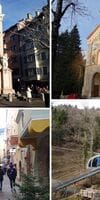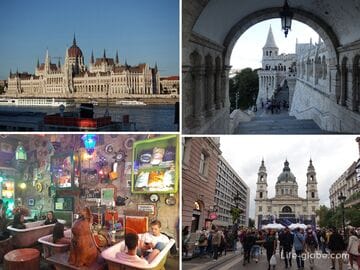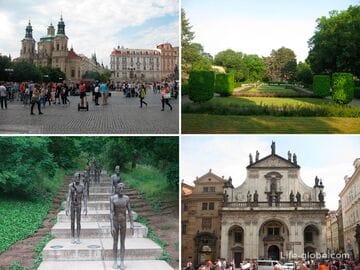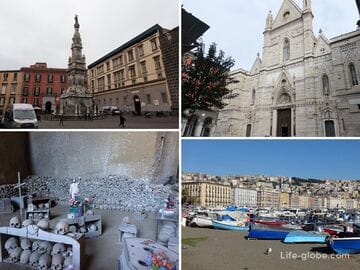The capital of Tyrol is the small and cozy city of Innsbruck, located in the Inn River Valley, surrounded by high mountain ranges on all sides.
This article provides the most comprehensive list of attractions, museums, significant sites and interesting places in Innsbruck. If you want to know only about the most important sights and main museums of the city, or you only have 1-2 days on Innsbruck, then you can see the list of TOP sights and museums here →
First of all, the city is known as a ski resort and the capital of several Olympic Games. Innsbruck becomes especially popular on Christmas Eve, when the city has Christmas markets, which are becoming one of the most visited places.
Nevertheless, at any time of the year Innsbruck can be an excellent solution for relaxation, as the city keeps in its arms a considerable number of attractions, including museums, viewing platforms, historical monuments and natural parks.
Even simple walks through the streets of the center of Innsbruck can bring a lot of pleasure, because from many corners of the city offers beautiful views of the towering mountains.
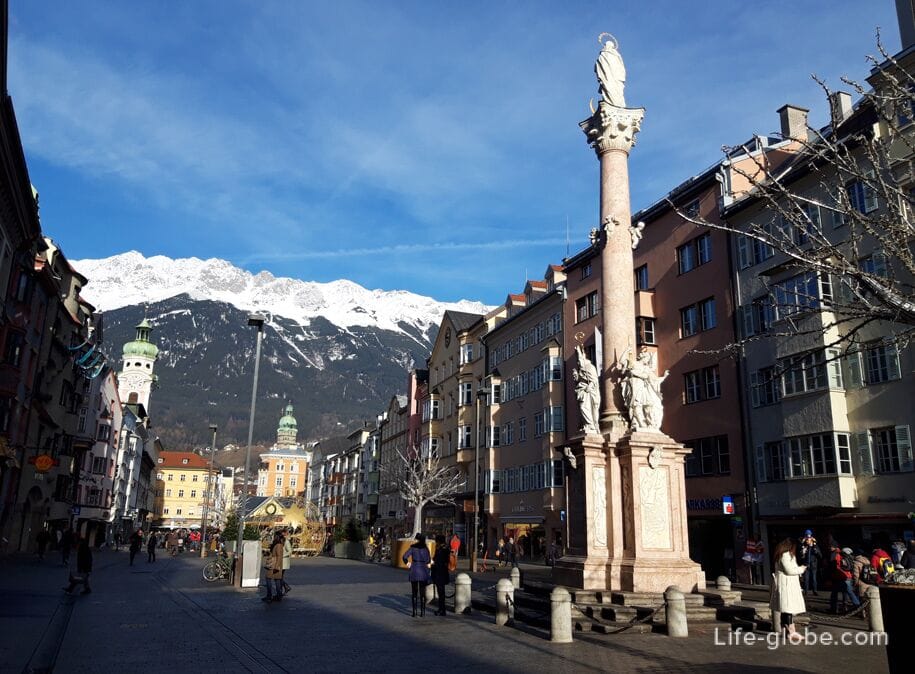
Sights of Innsbruck, Austria
Innsbruck Old Town
The old city of Innsbruck is truly a storehouse of sights, the basis of which is historical buildings lined up in tight rows along narrow streets, most of which are pedestrianized.
Initially, the old city was surrounded by a powerful medieval ring wall and a moat.
Today, the houses of the old city attract attention with colorful facades and various bay windows. On the ground floors of many buildings of the old city there are shops, boutiques, cafes and restaurants.
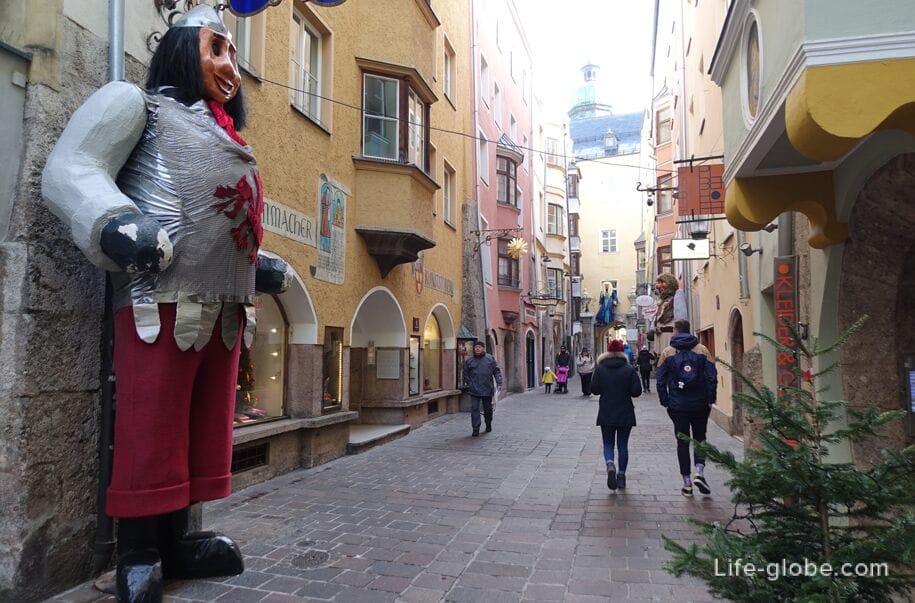
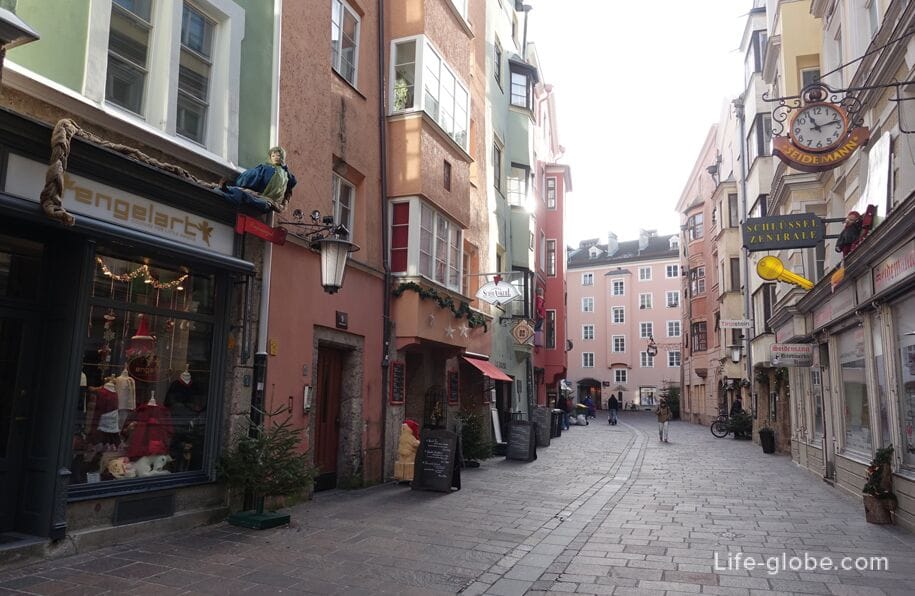
The main street of the old city is the pedestrian street of the Duke of Friedrich, the full name of the Herzog-Friedrich-Straße, which runs through the entire old city from north to south and along which there are many bright and significant historical buildings. Read more about Duke Friedrich Street ...
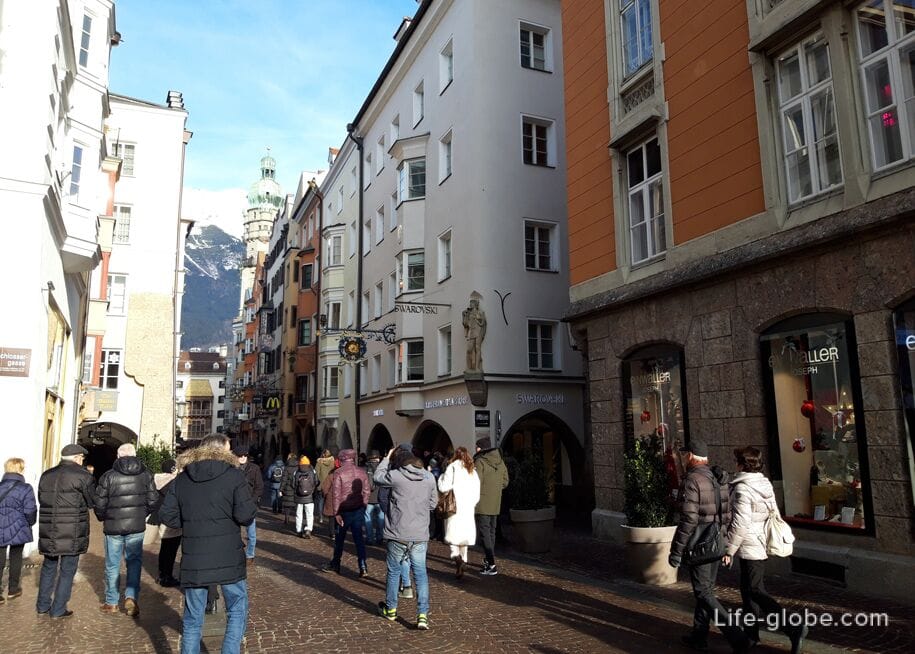
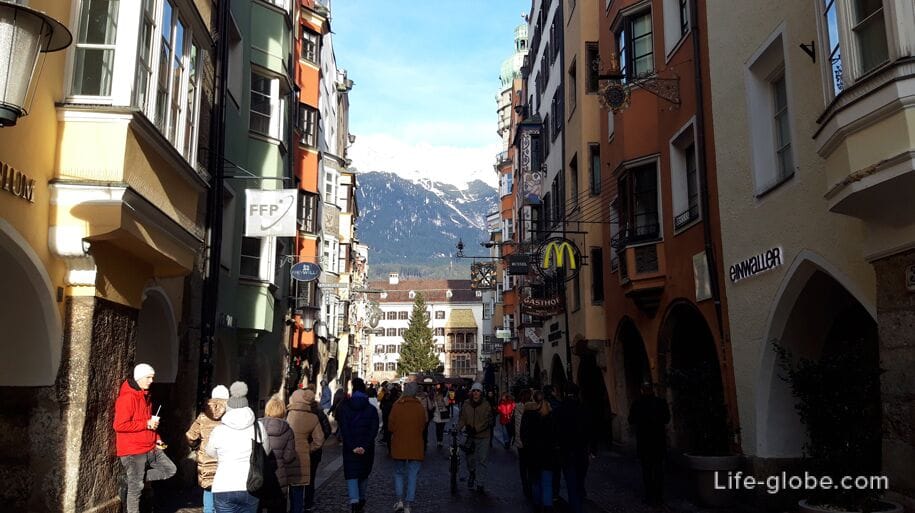
In the old town of Innsbruck, including Herzog-Friedrich-Strasse, there are such attractions as:
- Ottoburg is a late Gothic building, similar to a polygonal castle tower with ledges and indentations on the facade.
Address: Herzog-Friedrich-Straße, 1;
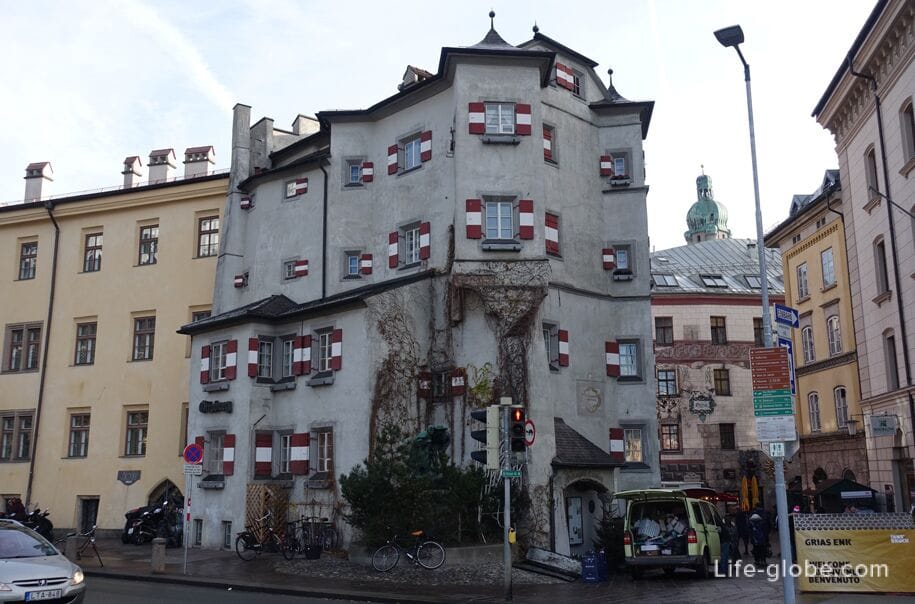
- Gasthof Goldener Adler is one of the oldest hotels in Innsbruck, founded in 1390 and rebuilt after a fire in 1450. This 4-star hotel at the Goldener Adler Innsbruck has a restaurant serving Tyrolean cuisine in this beautiful historic building.
Address: Herzog-Friedrich-Straße, 6;
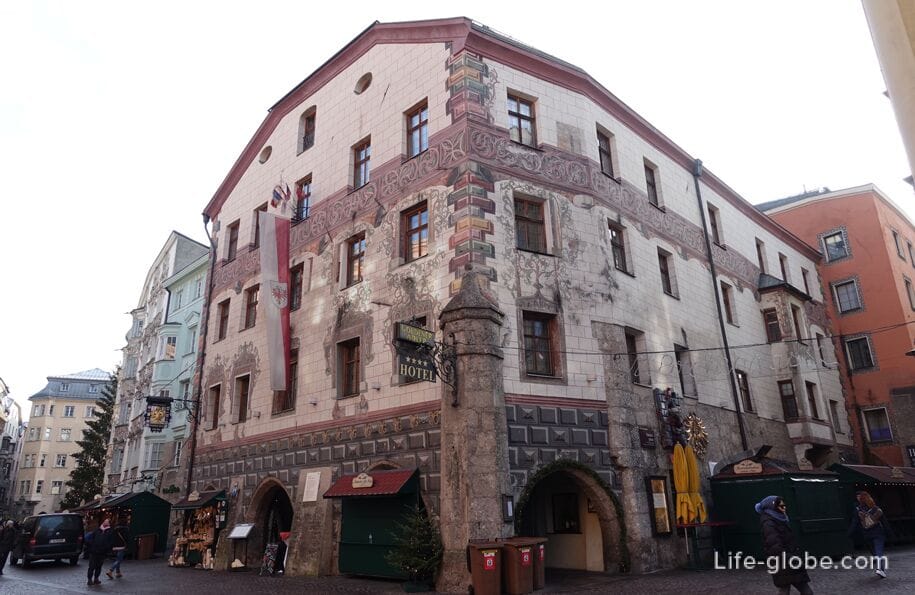
- Helblinghaus, originally a town house in the early Gothic style, like most of the nearby buildings, but in the 1725-1730s acquired a luxurious finish with Rococo stucco, which can still be seen today.
Address: Herzog-Friedrich-Straße, 10;
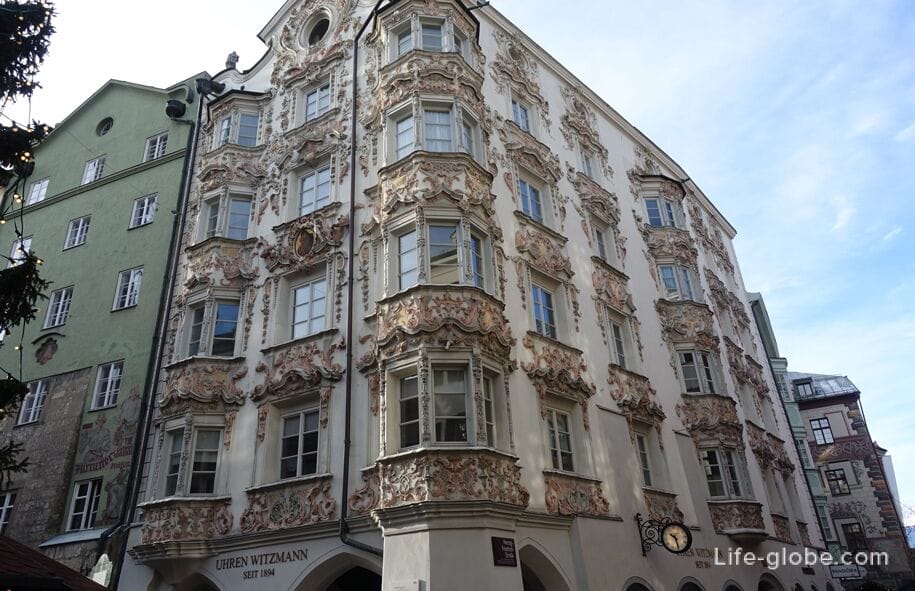
- house with a Golden Roof or simply the Golden Roof of Innsbruck (Goldenes Dachl) is one of the most recognizable buildings in the city, on the facade of which there is a bay window called the “Golden Roof”.
In the building with the Golden Roof, the Museum of Golden Roof is currently open.
Golden Roof Museum Site: innsbruck.gv.at.
Address: Herzog-Friedrich-Straße, 15;
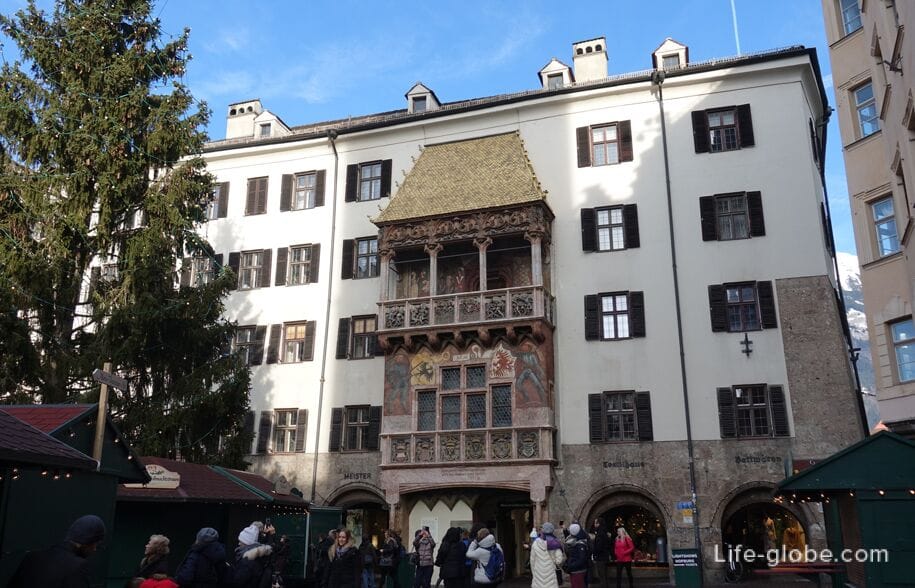
- the old town hall with the city tower (Stadtturm), in which, at an altitude of 31 meters, there is an open platform with iron railings and a mesh fence, which is a circular observation platform giving a 360-degree view of Innsbruck itself, mainly the historical center, mountains and nearby neighborhood.
Address: Herzog-Friedrich-Straße, 21;
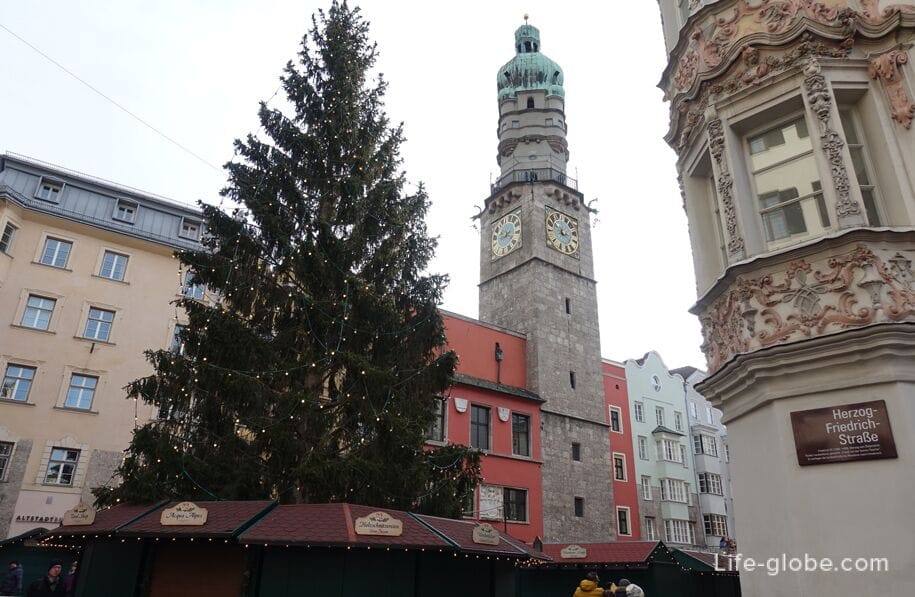
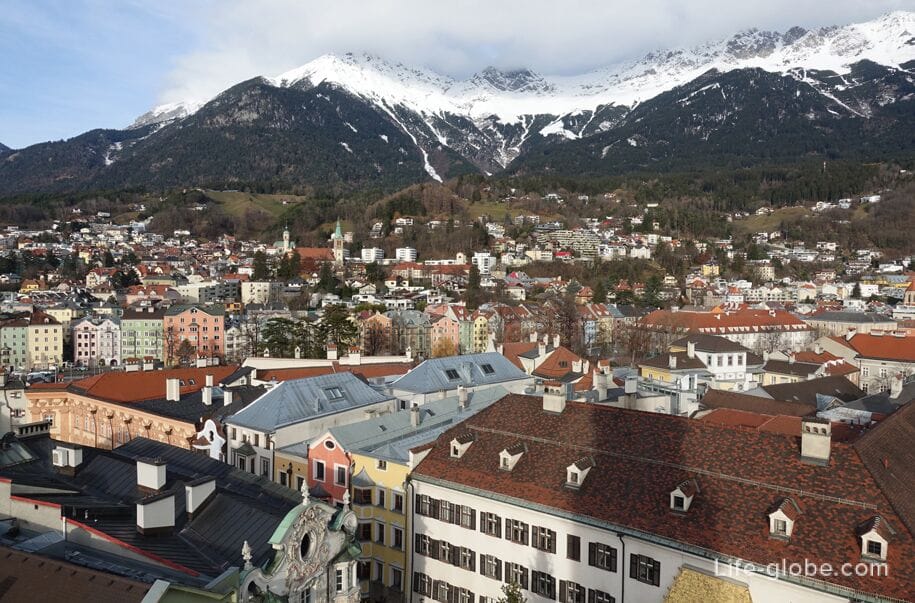
- Kaiserliche Hofburg - the former imperial palace, which was erected since 1453 and during the history has repeatedly expanded and restored, changing its appearance.
There is a museum in the palace, the pearl of which is the Main Hall (Ballroom) with frescoes on the ceiling and huge chandeliers;
Hofburg Museum Site: hofburg-innsbruck.
Address: Rennweg, 1;
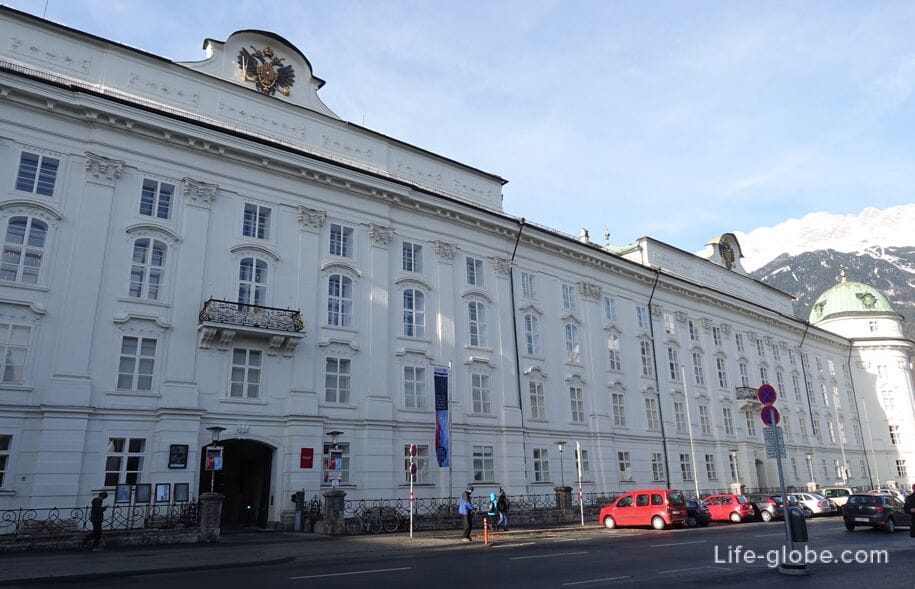
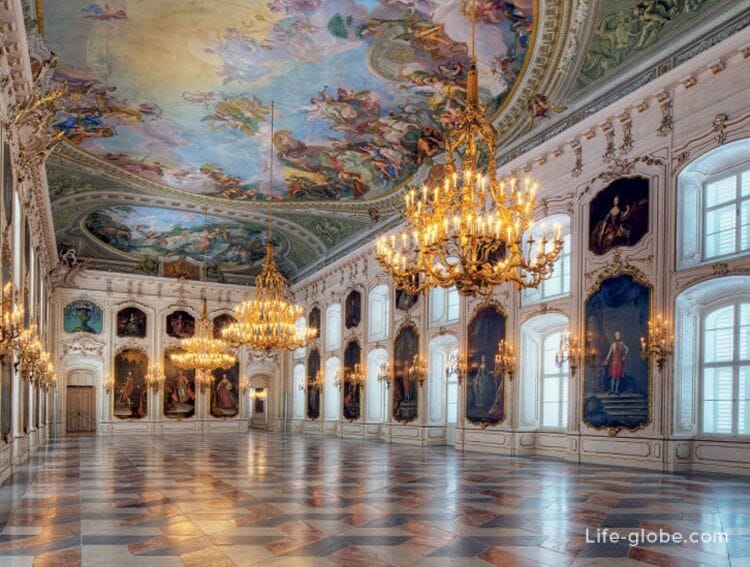
- Hofkirche - the former imperial court church, which, together with the adjacent Franciscan monastery, was erected in 1553-1563 by Emperor Ferdinand I as a monument to his grandfather Emperor Maximilian I.
Within the walls of the church are: a silver chapel, a Renaissance organ, a high altar and a ceremonial tomb - the cenotaph of Maximilian I, surrounded by 28 large black bronze statues depicting the ancestors, relatives and heroes of contemporaries of the emperor. For this reason, the church is also called the Church of the Black People.
Entrance to the church is paid. Hofkirche site: tiroler-landesmuseen.
Address: Universitätsstraße, 2;
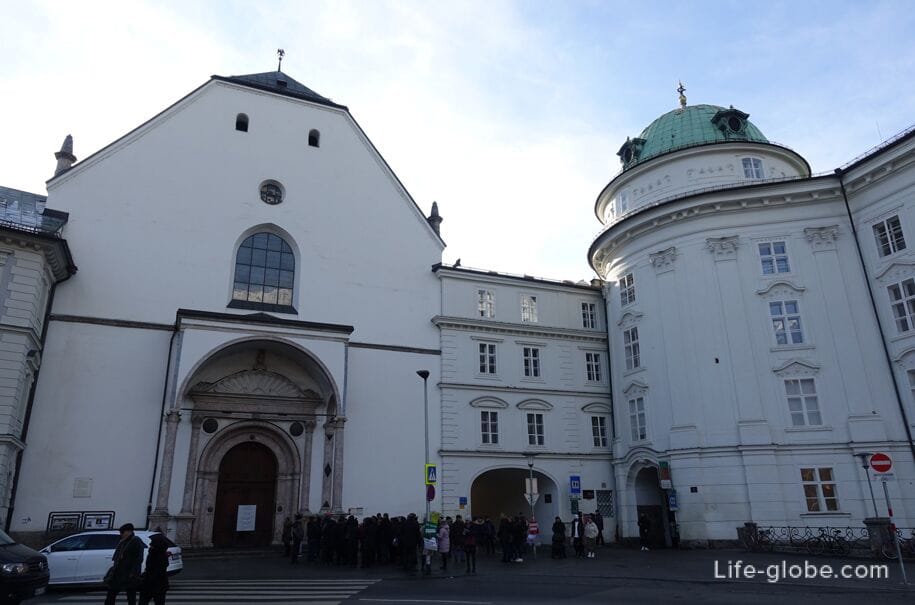
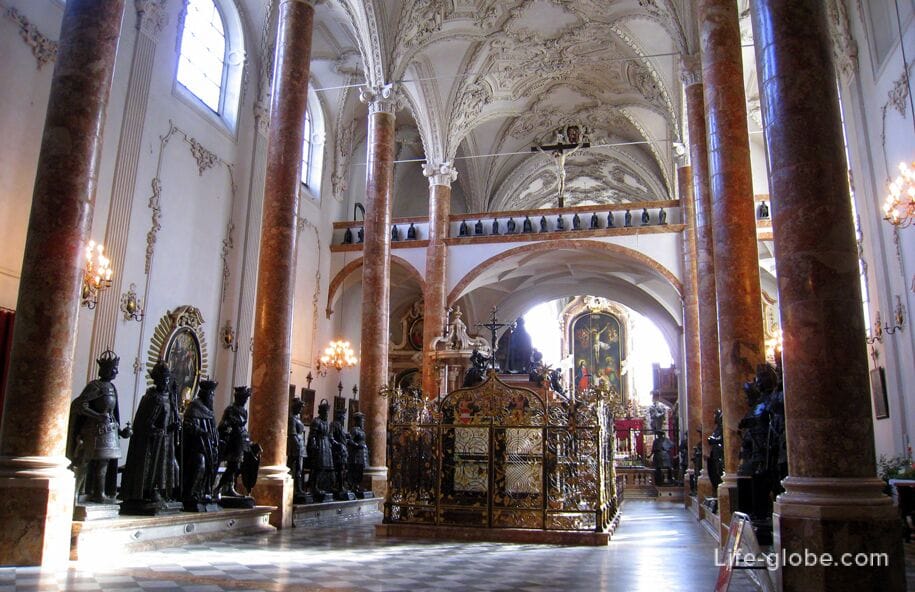
- Cathedral of St. James (Dom zu St. Jakom) is the main Catholic church of the city.
The appearance of the cathedral is quite modest and strict. However, unlike the exterior, the interior is distinguished by a luxurious baroque interior, in which marble, frescoes and stucco play with bright colors, where sculptures and sculptural compositions are located.
Address: Domplatz, 6;
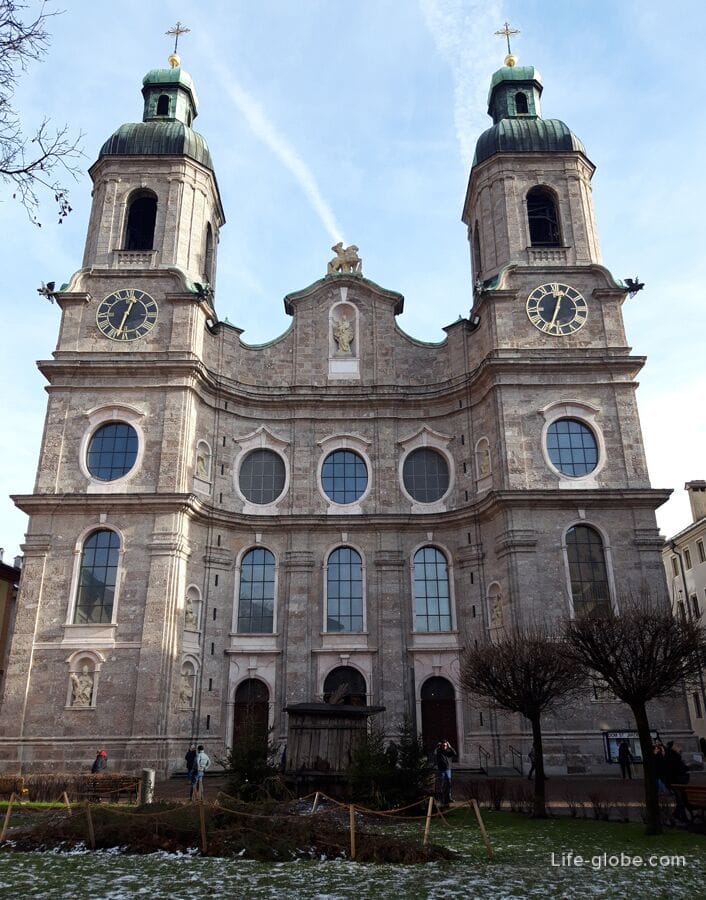
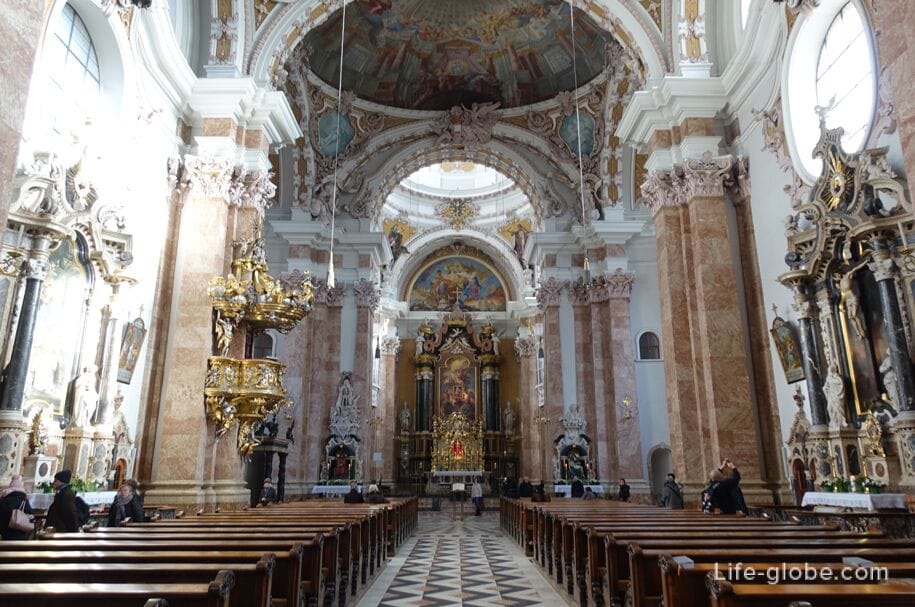
- Holy Trinity Jesuit Church or University Church (Jesuitenkirche), dedicated to the Holy Trinity and built from 1619 to 1640.
From the very beginning, the church was closely connected with the Jesuit Order, as its members had conducted theological lessons at the university since its founding in the 17th century.
>In the interior of the church are noteworthy: a baroque altar, a monumental dome and organ. In the crypt of the church are the graves of Archduke Leopold V and Claudia.
Address: Karl-Rahner-Platz, 2;

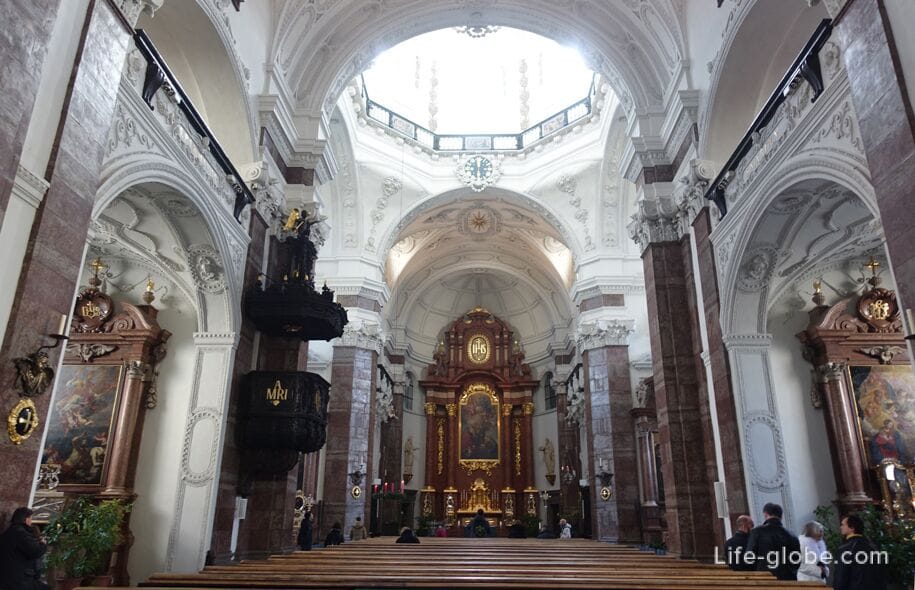
- The Tyrolean Museum Ferdinandeum (Tiroler Landesmuseen Ferdinandeum), located in a large historical building in the neo-Renaissance style (1842-1845).
The museum stores collections that tell about the history of the Tyrol region and not only - from the Stone Age to the present: relics, handicrafts, collections of works of art, drawings, prints, photographs, manuscripts, sculptures, musical instruments, library stock, etc. .;
Museum site: tiroler-landesmuseen.
Address: Museumstraße, 15;
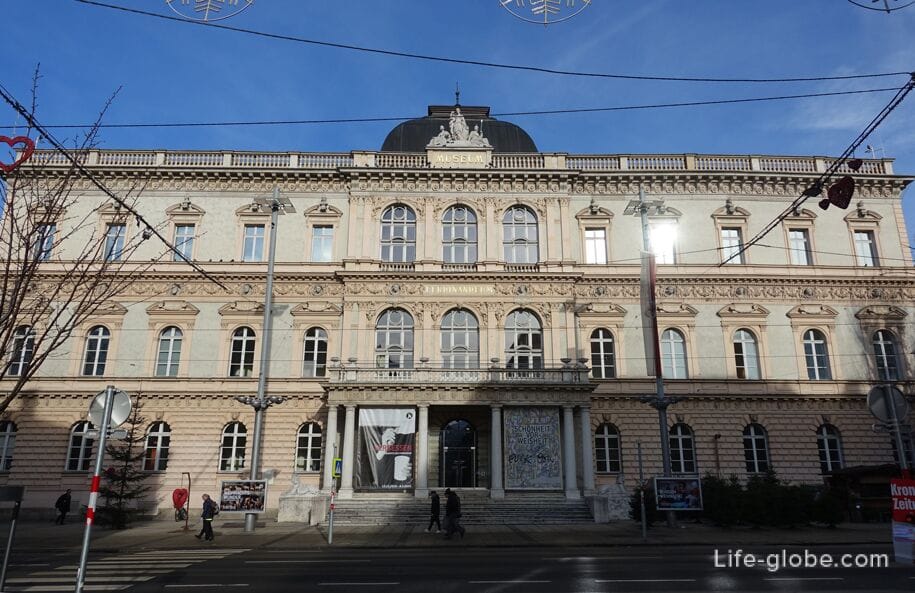
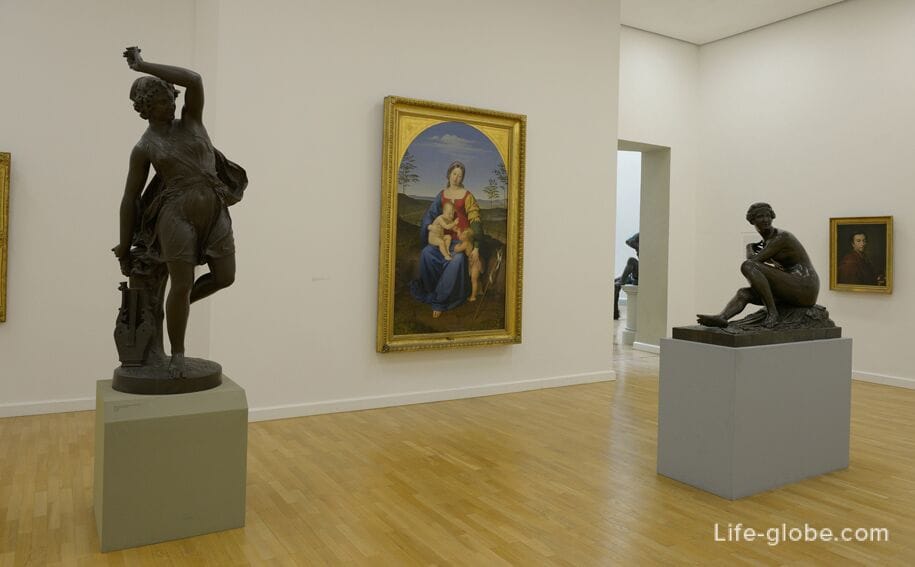
- Tyrolean Folk Art Museum (Tiroler Volkskunstmuseum), located within the walls of the former Franciscan monastery around the arcade courtyard.
The Renaissance building with a well-preserved monastery was used until 1785 as a Franciscan monastery, and then, mainly as a school, and since 1929 has been home to the Tyrolean Regional Heritage Museum.
The museum contains a collection of cultural exhibits from the local traditions of Tyrol, including peasant handicrafts and local items.
Museum site: tiroler-landesmuseen.
Адрес: Universitätsstraße, 2.
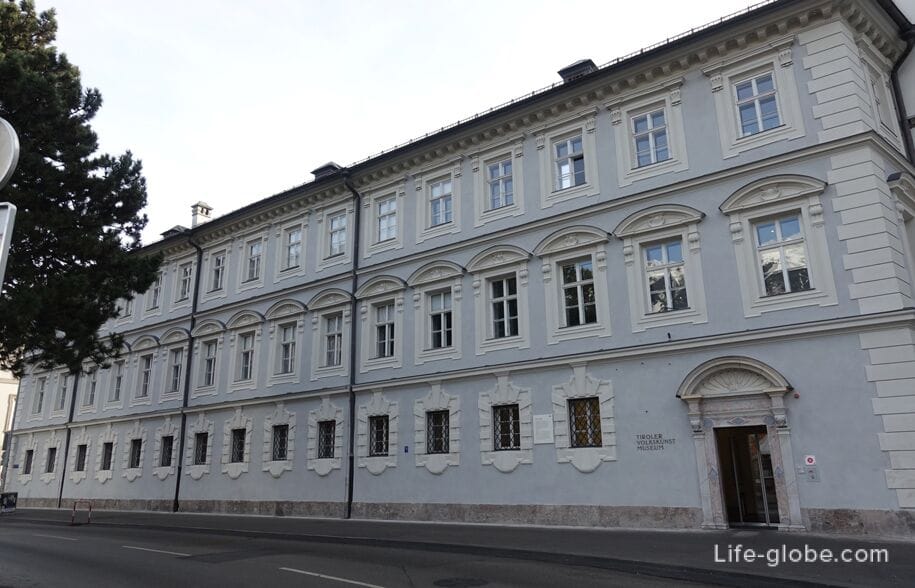
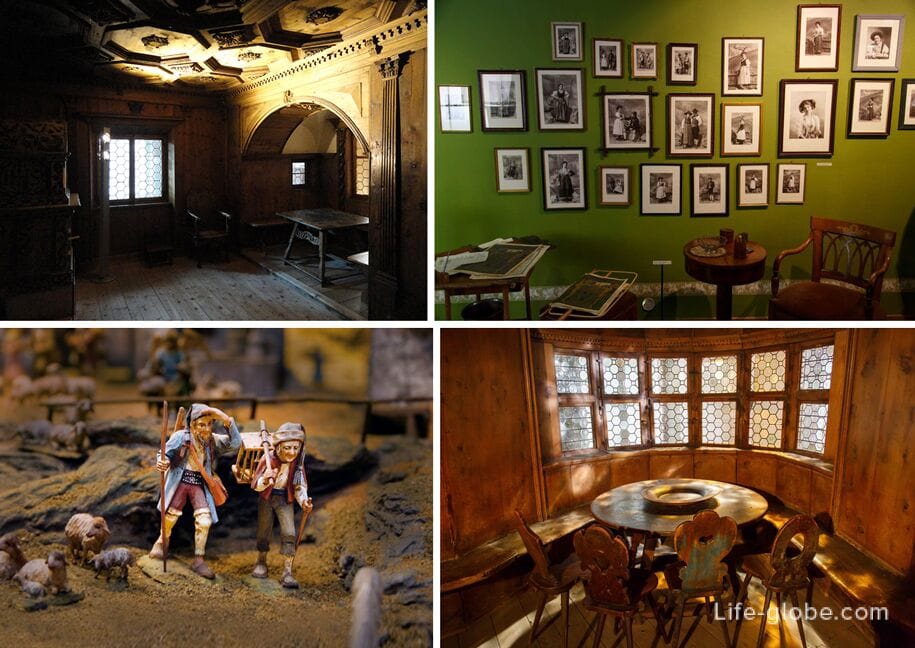
Read more about Innsbruck's old town...
Street of Maria Theresa ("New Town" of Innsbruck)
Street of Maria Theresa (full name - Maria-Theresien-Straße) is another of the main and busiest streets of the center of Innsbruck.
The street was formed when the city of Innsbruck began to expand, and went beyond the old city - beyond the city walls and the moat. The new part of the city, which at that time was a suburb, developed along the arterial road leading south to Wilten (now the Innsbruck district) and was known as "Neustadt" or "New Town".
Currently, Maria Theresa Street has a length of about 500 meters, a slightly curved shape and the northern part of the street is a pedestrian zone.
Along the street are historical buildings, most of which are represented by Baroque buildings, there are boutiques, shops, including two shopping centers, as well as cafes and restaurants.
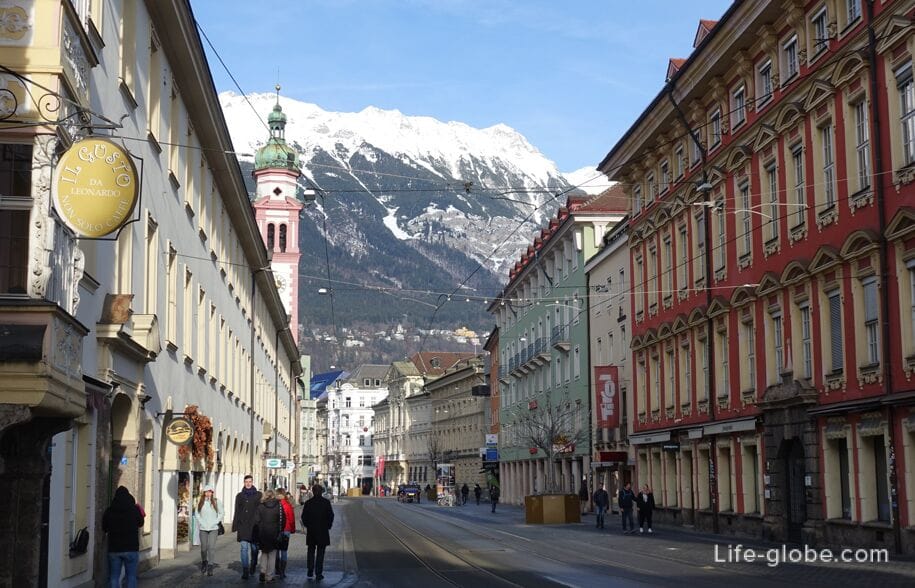
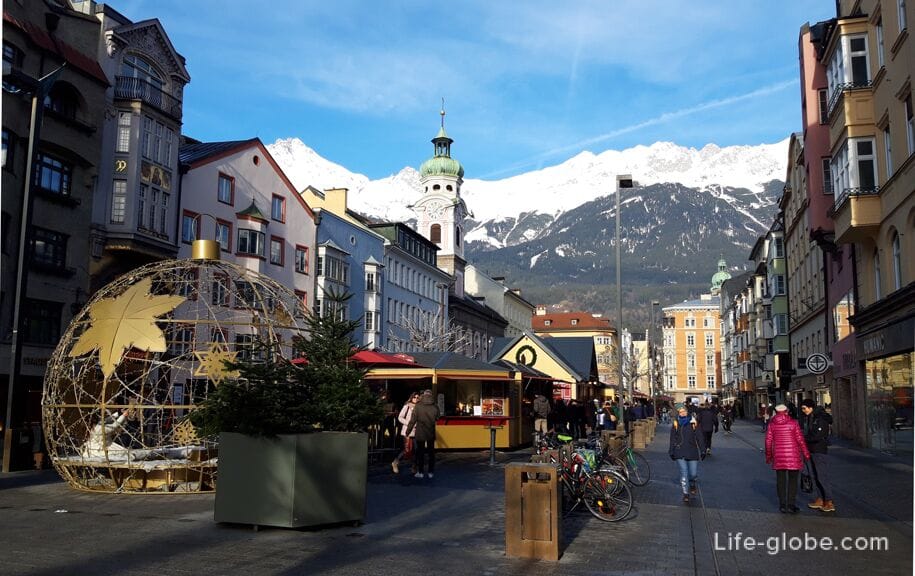
Sights of Maria Theresa Street:
- the old hospital church of the Holy Spirit (Spitalskirche zum Heiligen Geist), which was first mentioned from the 12th century (1320s) as a chapel at the hospital and since 1381 was called the “church”.
The church was rebuilt in the years 1700-1701 in the Baroque style.
The details of the church are noteworthy: carved doors, stucco decorations, a high altar with a Gothic cross and frescoes dating from the 1960s.
Address: Maria-Theresien-Straße, 2;
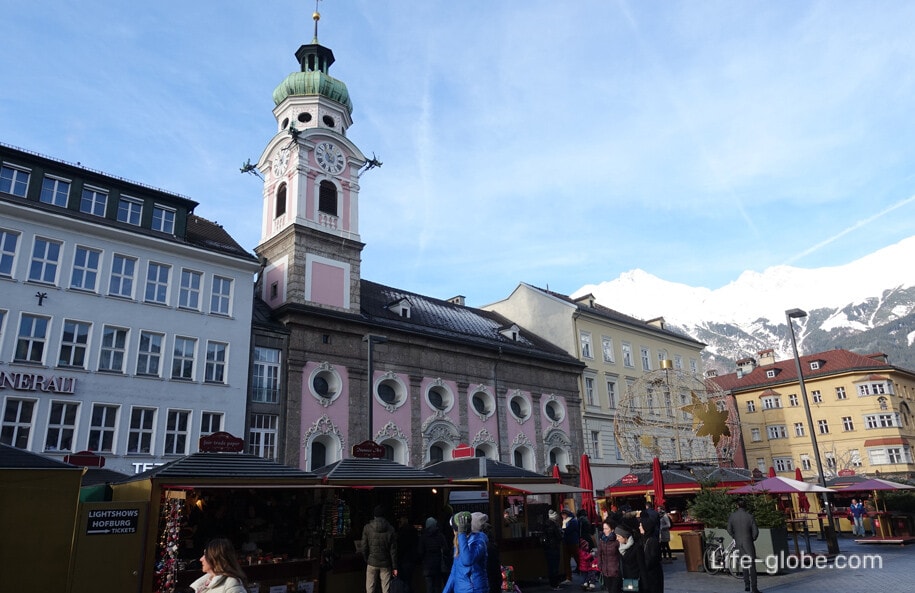

- Gasthaus Alt Insprugg is a 15-16th-century house, on the facade of which you can see the numbers “1577”, rebuilt during the Baroque and in 1906.
Address: Maria-Theresien-Straße, 16;

- St. Anne's Column (Annasäule / St. Anne's Column), which stands in the center of the street and is one of the symbols and one of the main attractions of Innsbruck.
The column was erected after the war for the Spanish heritage (Bavarian invasion), as a thank you to the higher forces for the victory. The enemy was defeated, and the last Bavarian troops were expelled July 26 - the day of St. Anne. Hence the name “column of St. Anne”;
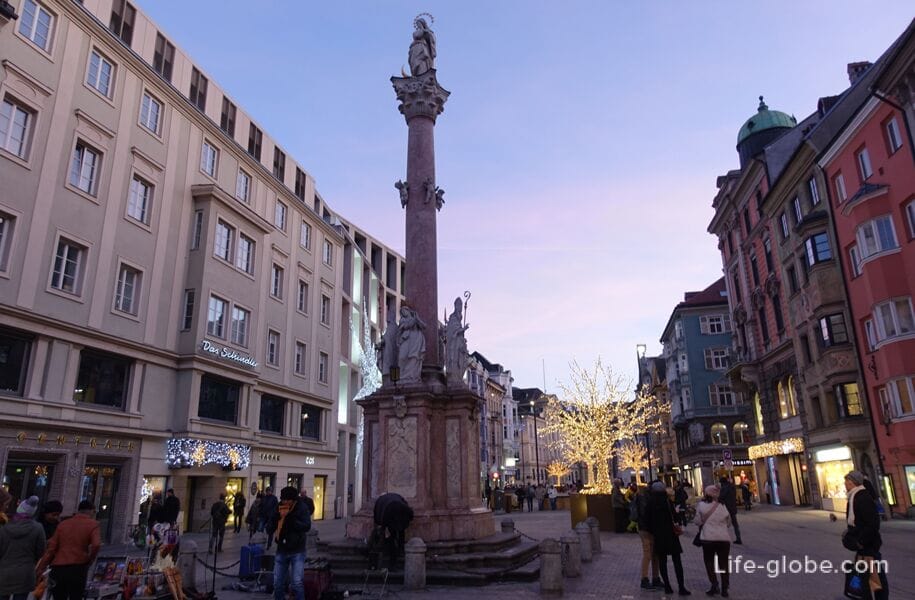
- new town hall (shopping center), the building of which was expanded and partially acquired a new modern architecture with glass and steel structures by 2002.
Now the building of the Town Hall, in addition to the new premises for the city administration, includes the 4-star design hotel The Penz with a rooftop garden restaurant, the RathausGalerien shopping arcade, an underground car park and a rooftop bar (7th floor) with 360-degree panoramic view.
Shopping mall website: rathausgalerien.
Address: Maria-Theresien-Straße, 18;


- Servit Church of St. Joseph (Servitenkirche zum hl. Josef) with an adjoining monastery, founded in 1614 by the widow of Archduke Ferdinand II Anna Katarina Gonzaga.
The monastery flourished in the 17th century thanks to funding from the Habsburg family. The first monastery and church building burned down in 1620. The church was later rebuilt and consecrated (1626).
Later extensions concerned the side chapel (1722) and the Peregrini chapel (1731). The baroque tower of the church was erected in 1899.
Today the church is a simple building with a south baroque tower and a protruding chapel. Inside you can see elements of several eras, from the early Baroque to the present.
Address: Maria-Theresien-Straße, 42;
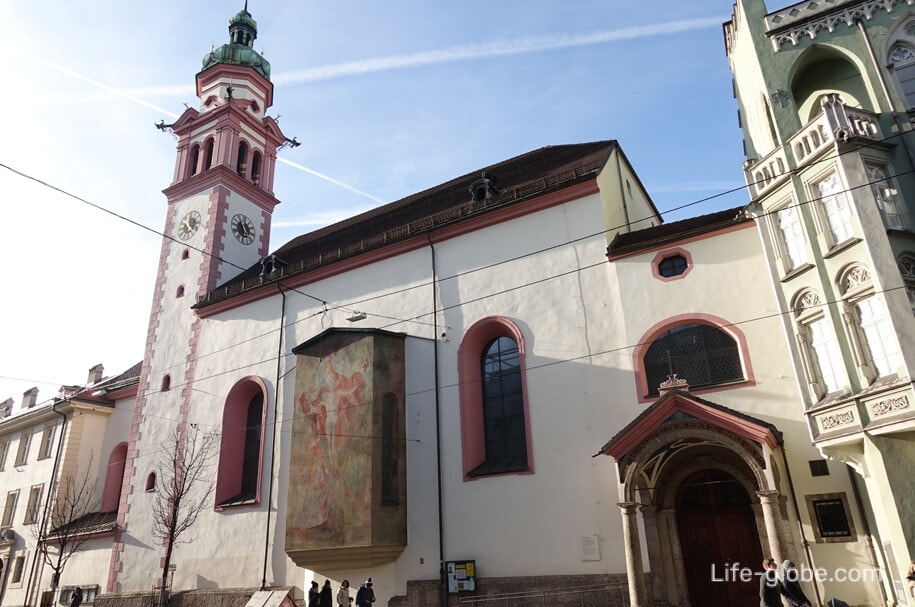
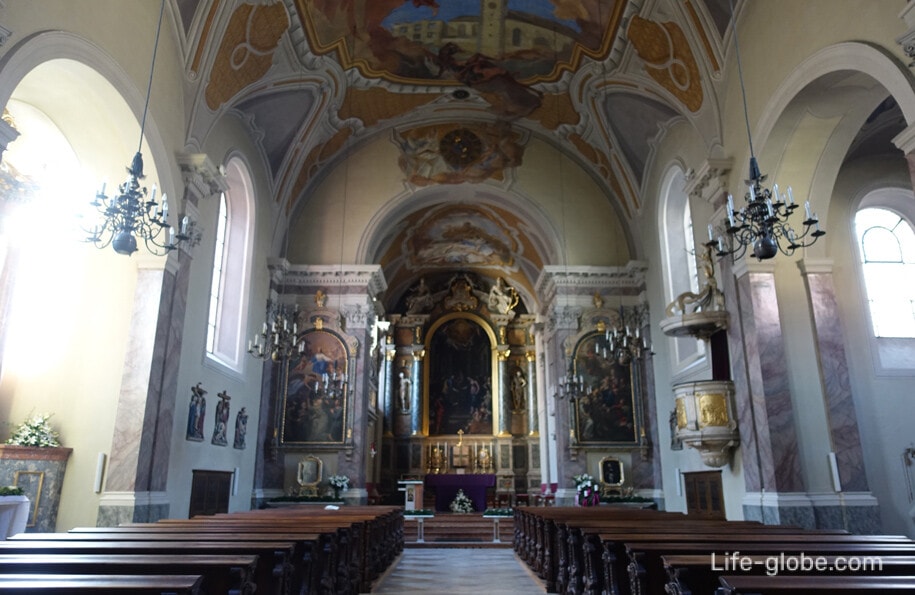
- Triumphal Arch (Triumphpforte), commissioned by Maria Theresa in the 18th century, when the Empress planned the marriage of her son Archduke Leopold with the Spanish princess Maria Louis.
In addition to the main entrance symbol to the historical part of the city, the triumphal arch also serves as a reminder of joy and grief at the same time. The fact is that during the preparation for the wedding, on August 18, 1765, the husband of the empress and the father of the groom died.
For this reason, the triumphal arch has two "faces": on the north side of the gate are memorial motifs in memory of the sudden death of the emperor, and the south is decorated with festive and brighter motifs with reliefs dedicated to the wedding.
Address: the arch is located at the southern end of Maria Theresa Street, near the house at 2 Leopoldstraße.
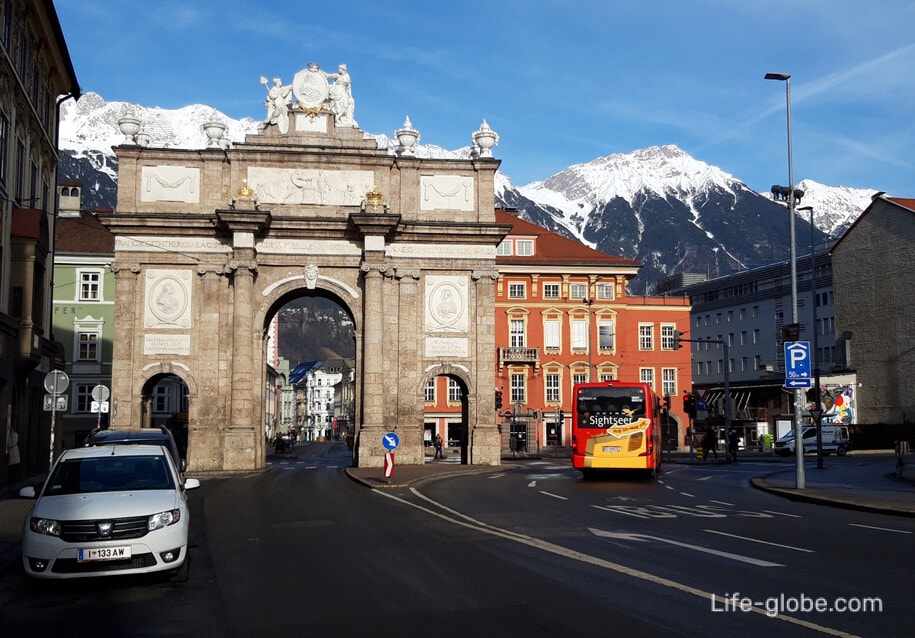
In addition to the above, a lot of historical Baroque palaces rise along Maria Theresa Street, for example, the old country house, Trapp Palace, Fugger Taxis Palace and Peterlongo House. Learn more about Maria Theresa Street
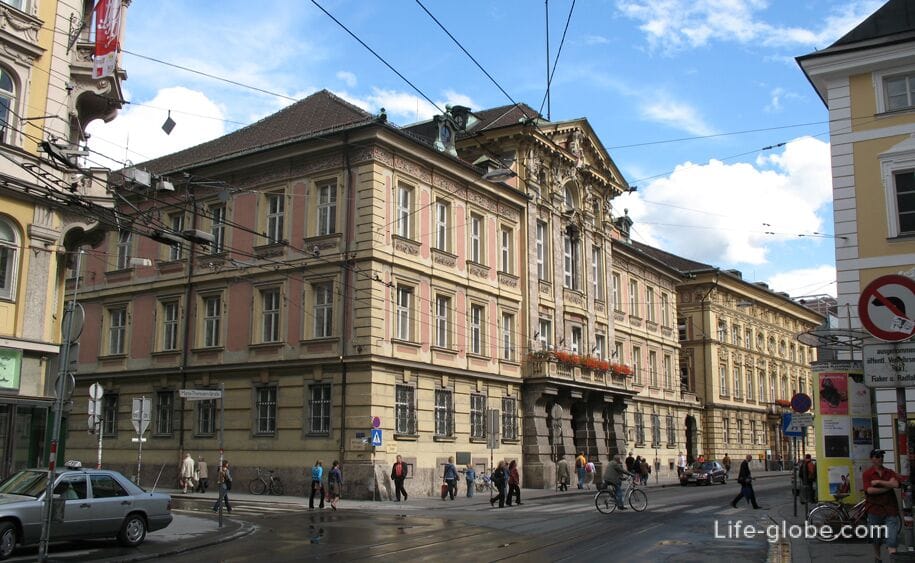
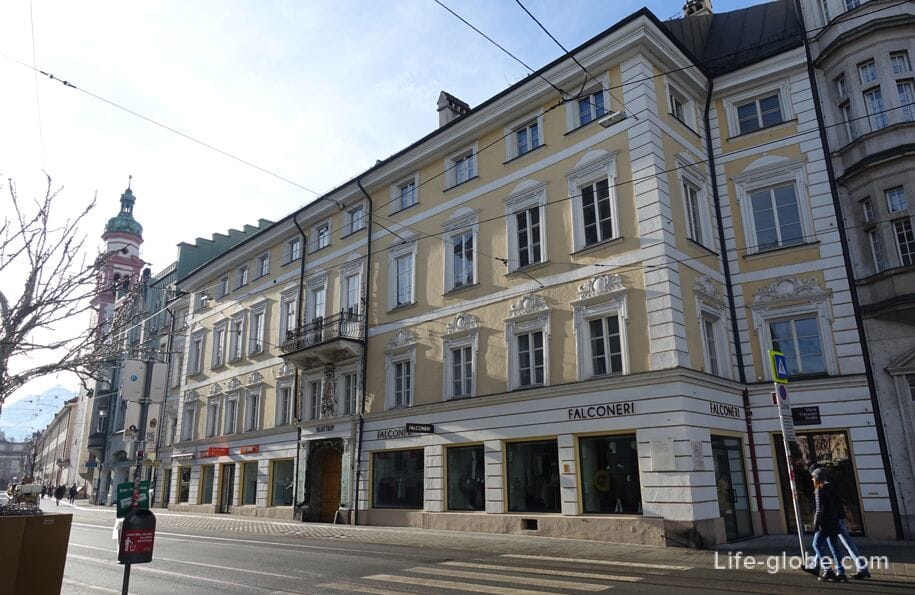
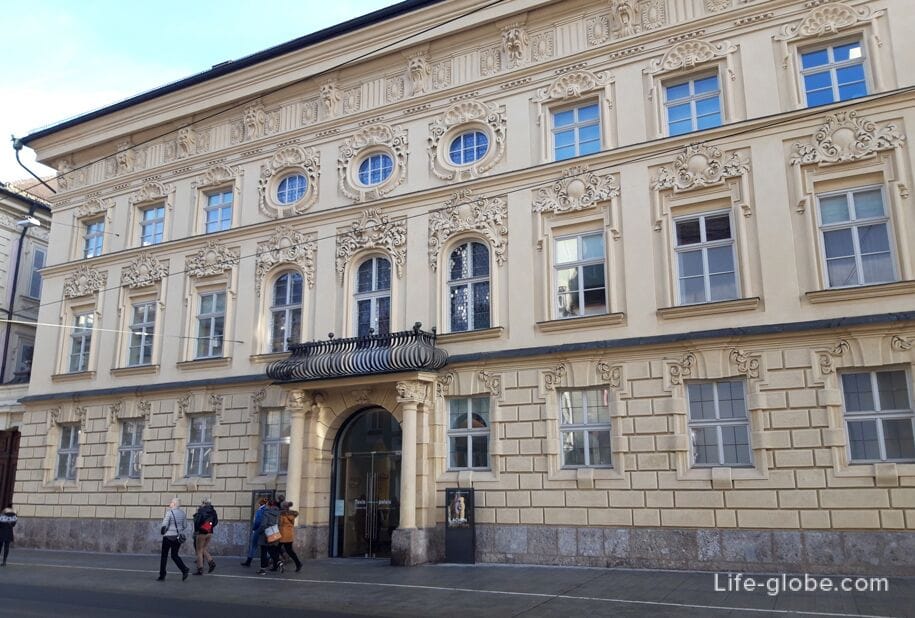
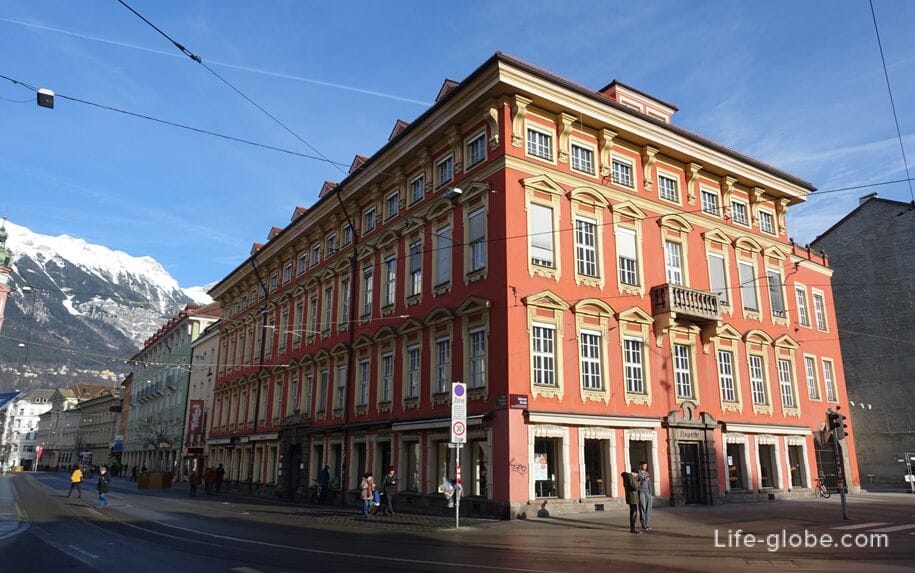
"New City" of Innsbruck
The so-called "New City" of Innsbruck, which takes its origin from Maria Theresa Street, was formed and grew around this street.
Together, the New and Old Town of Innsbruck form the center of modern Innsbruck and the most visited and lively part of the city.
Sights of the "New City" of Innsbruck:
- Hofgarten park or the court garden (Hofgarten), which is a protected area and originally laid on the site of a river meadow under the direction of Archduke Ferdinand II in the sixteenth century. At that time, it was one of the most complex gardens to the north of the Alps.
Currently, the park is a recreation area with lots of greenery, a children's playground, a palm house and the Tyrolean art pavilion.
The park is located near the Hofburg Palace;
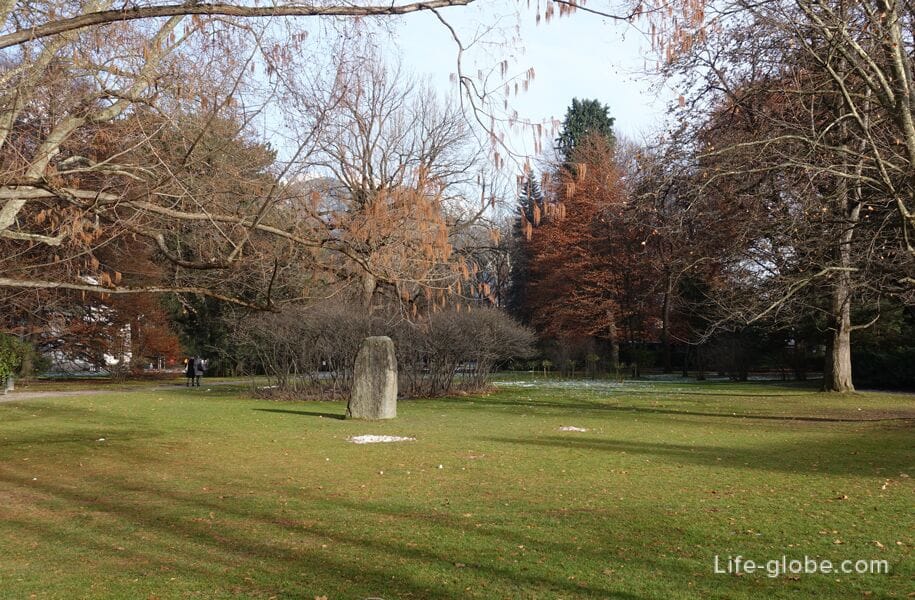
- the intersection of Rennweg and Universitätsstraße streets near the Hofburg and Hofkirch palace, form an open space - square near the Hofburg palace, on which there are:
- concert hall "House of Music" (Haus der Musik), which is a multi-purpose building, built and opened in 2018 on the site of the former city hall.
Concert Hall Site: haus-der-musik-innsbruck;

- Tyrolean State Theater (Tiroler Landestheater), whose history dates back to 1629.
In 1654, a new house, built by Christoph Gump, was opened on the other side of Rennweg, exactly where the State Theater now stands. The court theater was reconstructed in 1765 and rebuilt due to disrepair in 1844-1846, then expanded.
Theater website: landestheater;
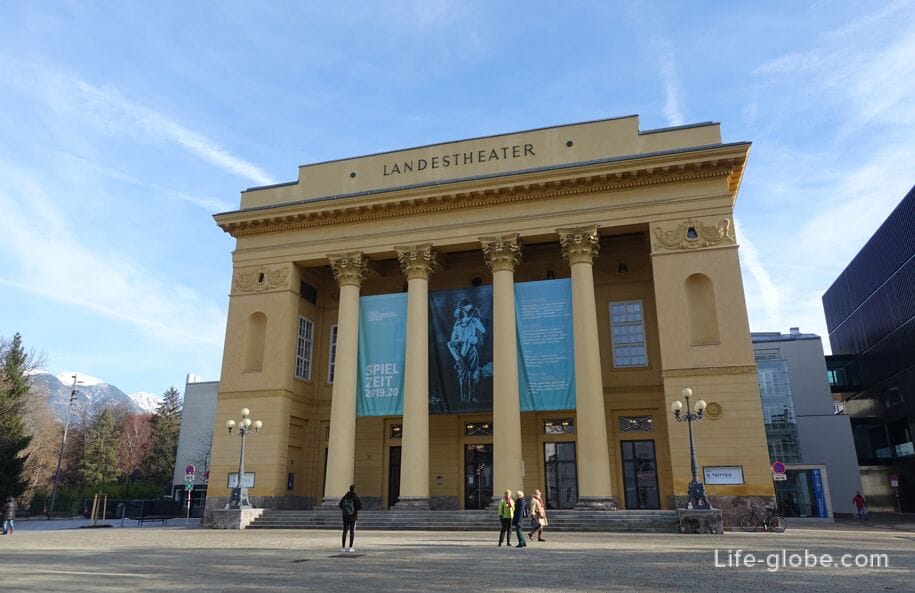
- Leopold Fountain (Leopold V fountain), which adorns the sculptural composition, the central place of which is the equestrian statue of Archduke Leopold V, who lived from 1586 to 1632 and gave his name to the fountain.
The fountain was erected under Leopold V between 1622 and 1630, as a symbol of his strength and authority. However, it was not until 1893 that the fountain acquired its present appearance;

- Temple of the Sacred Heart (Herz-Jesu-Kirche) - Serbian Orthodox Church. Until 2019, it was a Catholic church.
The shrine was built between 1896 and 1898 and served as the monastery church of the adjoining Redemptorist College until 2019.
Address: Maximilianstraße, 8;
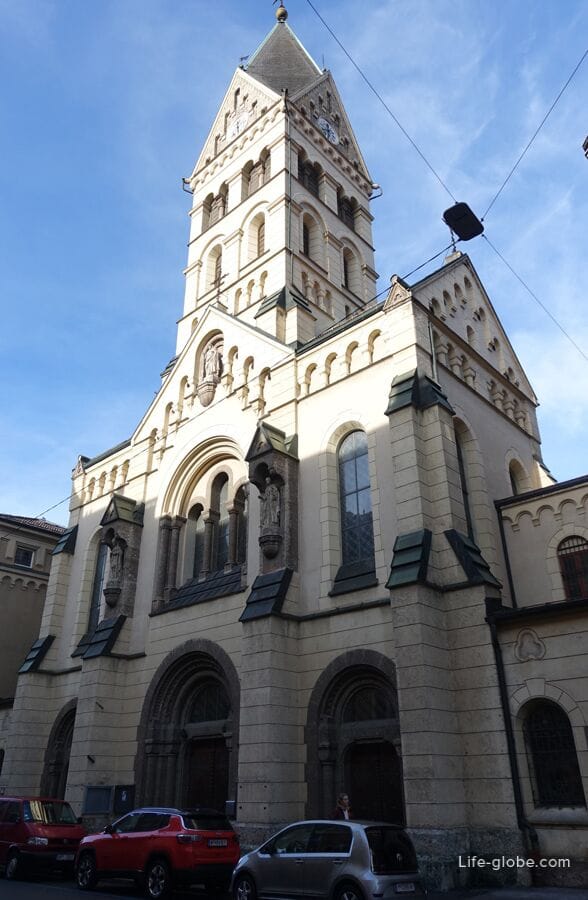
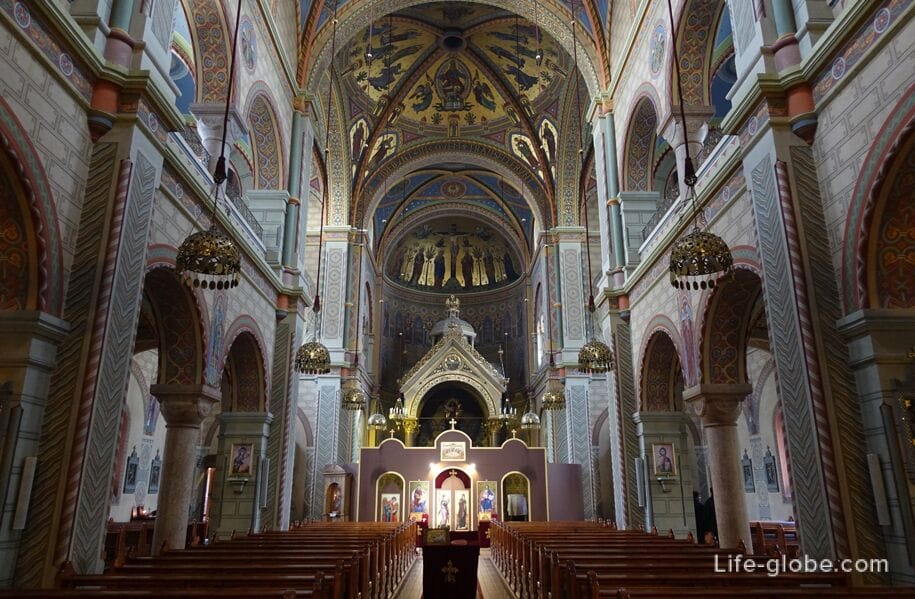

- Inbruck University named after Leopold and Franz (Universität Innsbruck), founded in 1669 and today is the largest educational and research institution in western Austria.
In 1562, a Jesuit school was founded in Innsbruck. In 1669, by decree of Emperor Leopold I, a comprehensive university was created on the basis of the school with four faculties, including law and medical schools. In 1782, the status of the university was reduced to a lyceum, but in 1826, at the initiative of Emperor Franz II, the status was returned and the university was called the University of Innsbruck. For this reason, the university bears a name in honor of both the founding fathers of the University of Leopold and Franz in Innsbruck.
Address: Innrain, 52;
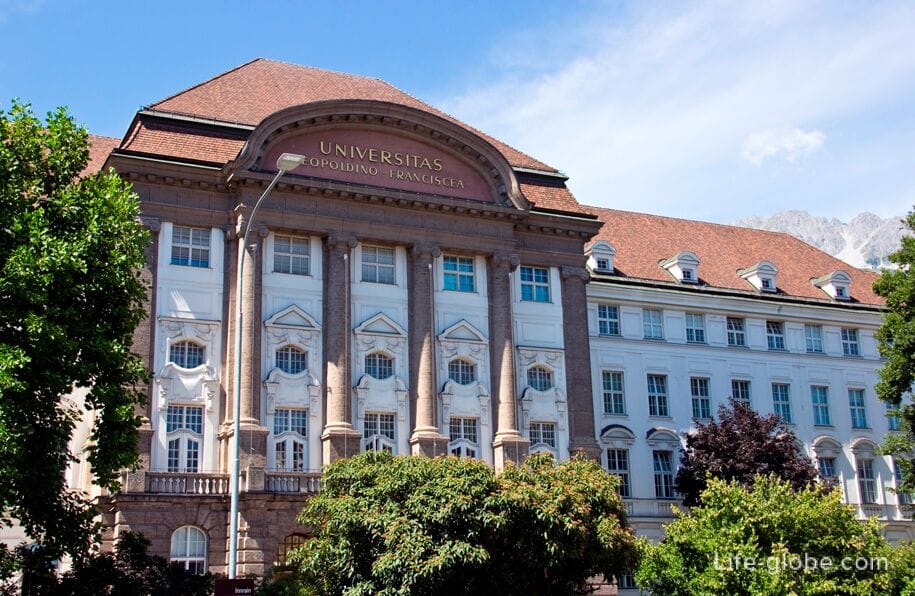
- Former Ursulin Church (Ehemalige Ursulinenkirche). The Order of the Ursulin Sisters arrived in Innsbruck in 1691 at the initiative of Count Jerome Bernhard Ferrari d'Ochecheppo and was the first and long time only institution dedicated to teaching girls.
Address: Innrain, 7;
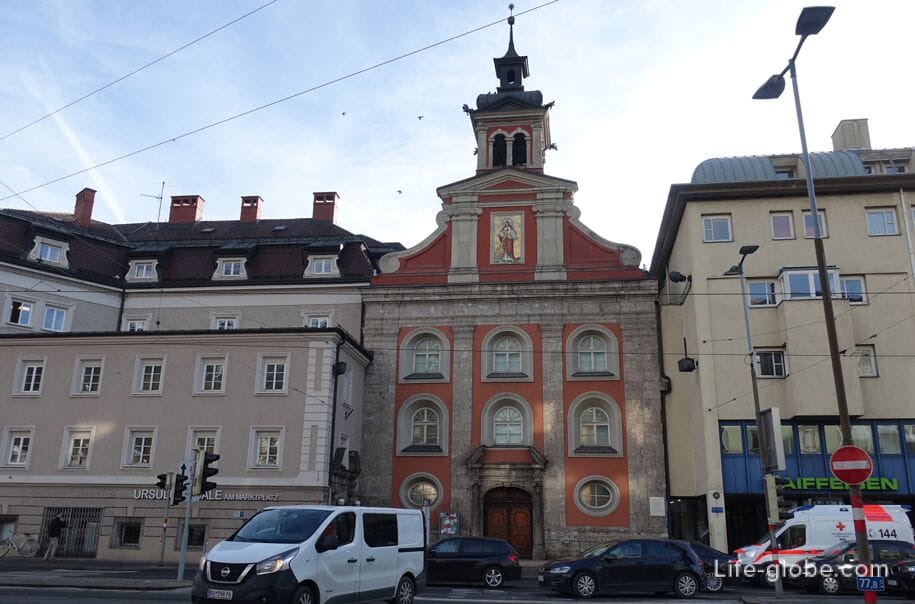
- Innsbruck Market (Markthalle Innsbruck) - a large covered market in the historical center of Innsbruck that combines in one building, traditional farmer and craft markets with permanent food departments.
Address: Herzog-Siegmund-Ufer, 1-3;
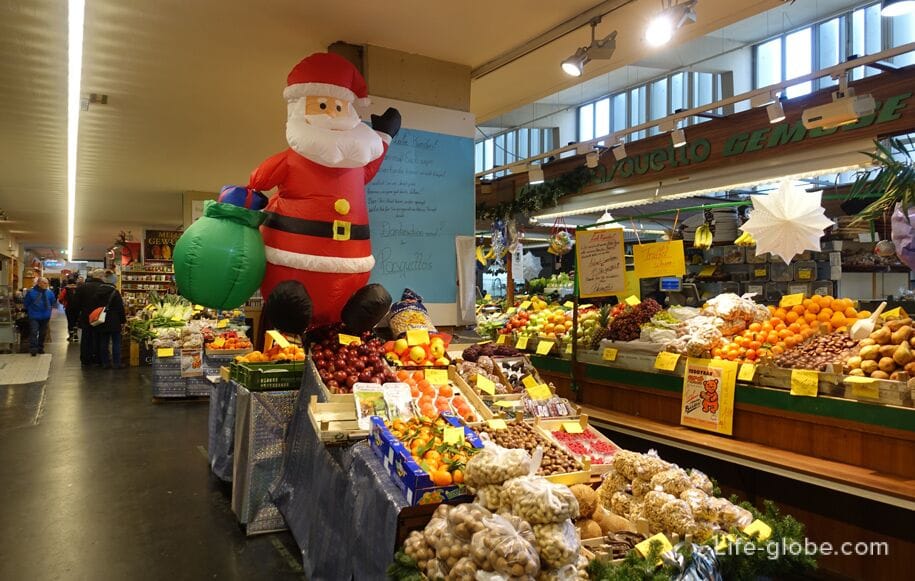
- Eduard Wallnoferz Square (Eduard-Wallnöfer-Platz), named after the former Tyrolean governor of Wallnofer and relating to modern architecture.
The square, built in the late 1930s, is decorated with several monuments. Also, obstacles and ramps in the square provide an opportunity for training skateboarders;
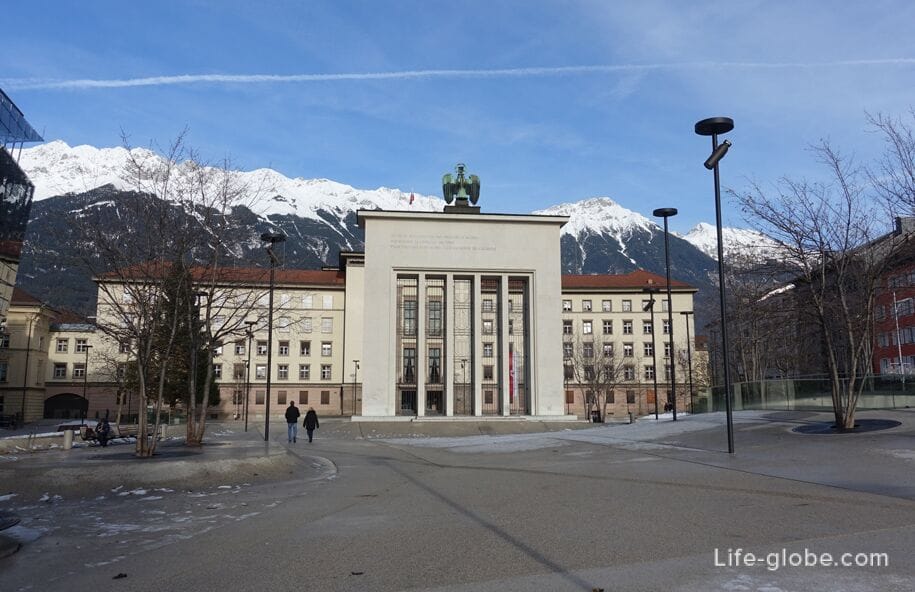
- Rudolf fountain or Rudolfsbrunnen, which is a historical monument.
The fountain was installed on Bozner-Platz in 1877, in honor of the celebration of the 500th anniversary of Tyrol with belonging to Austrian countries (1363-1863). The design was designed by Friedrich Schmidt. A bronze statue of Duke Rudolph IV is installed on the fountain with a coat of arms.
Address: Bozner Platz;
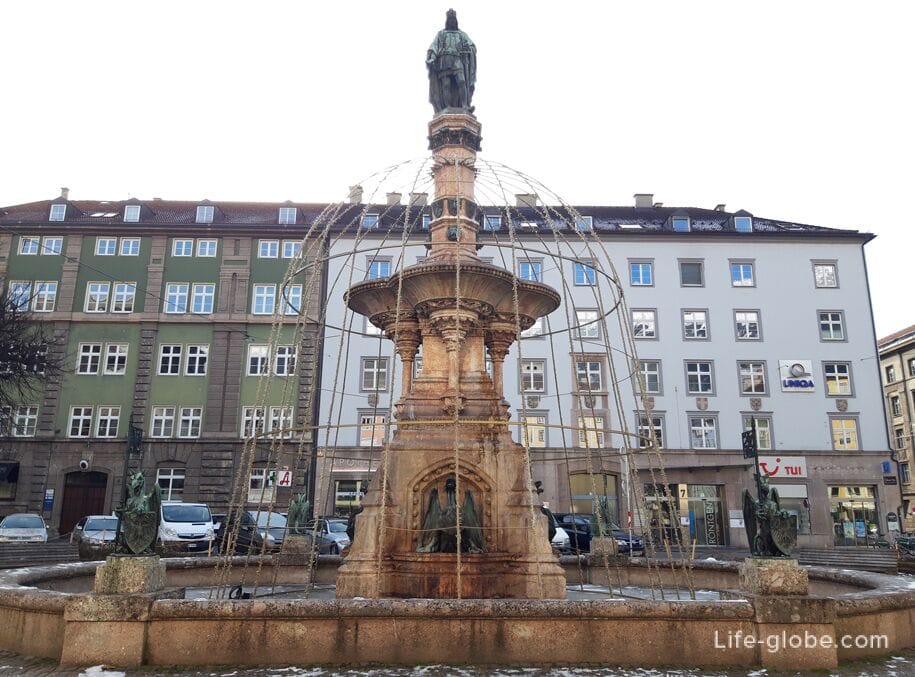
- Capuchin Monastery with an adjoining church (Capuchin Monastery Innsbruck), which is the oldest in Austria-South Tyrol and Germany. It was founded in 1593-1594 by the Tyrolean prince, Archduke Ferdinand II and his second wife, Anna Katarina von Mantova.
Under Emperor Joseph II from 1797 to 1802 and during the Nazi period from 1940 to 1945, the monastery was closed.
In the 17th century, the monastery was expanded and since 1857 has the current look in the style of classicism.
The church building is a very simple gray building with a tower, pilasters and a small portal with marble framing.
Address: Kaiserjägerstraße, 6;
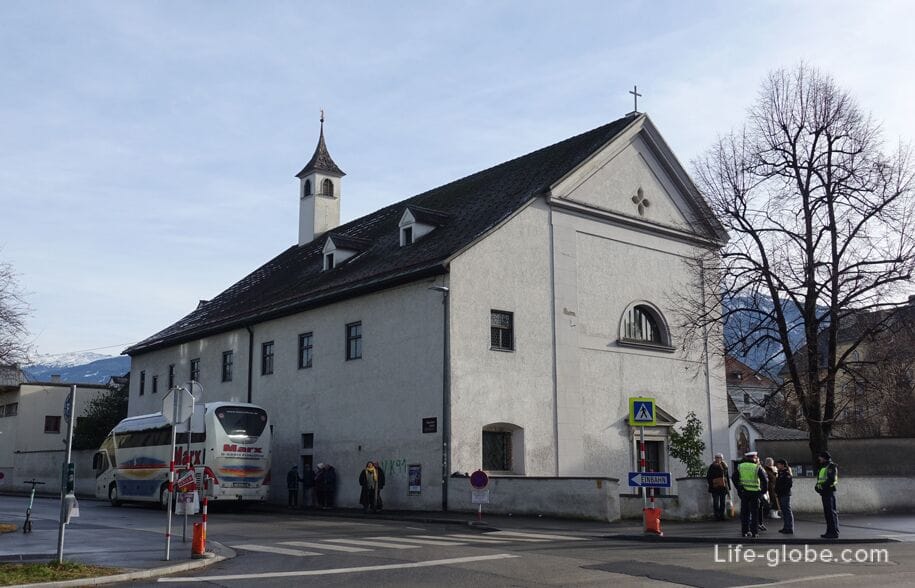
- Monastery Church of the Adoration (Klosterkirche zur Ewigen Anbetung). The monastery, founded by Maria Pia (Sophie) von Angelini in 1869-1870, was built in the deer park (Hirschanger) of the former Innsbrick Zoo and consecrated in 1872.
The facade of the mosaic dates from 1895. The monastery was assigned by the National Socialists in 1940 and rebuilt after the war.
Address: Karl-Kapferer-Straße, 7;

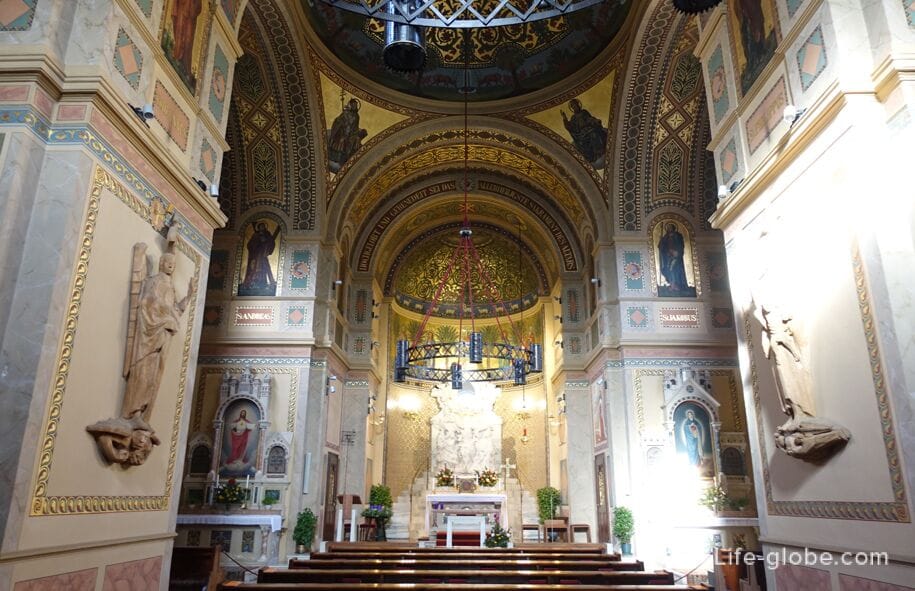
- Kanisianum College (Collegium Canisianum) is a Jesuit institution that is an international theological school. Currently, about 40 priests from around the world live in it.
Konisianum dates back to the 16th century, and since 1911 bears the name of the first German-speaking Jesuit Peter Kanisius (1521-1597), who, in addition to founding a school in Innsbruck, worked in many other places in Germany, Austria and Switzerland.
Built in 1910-1911, Konisianum became the successor to the Theological Seminary, founded in 1858 on Silgasse Street. Theologians from around the world lived here. Since 2013, they have been located at Sillgasse 6, while the Konisianum building is currently mainly used as a student hostel.
Address: Tschurtschenthalerstraße, 7;


- Federal Trade Academy and Federal Trade School (Bundeshandelsakademie and Bundeshandelsschule). The building of the Commercial Academy was built in 1904 in the style of the so-called "Tyrolean Gothic", expanded and rebuilt in 1971-1977.
Address: Karl-Schönherr-Straße, 2;
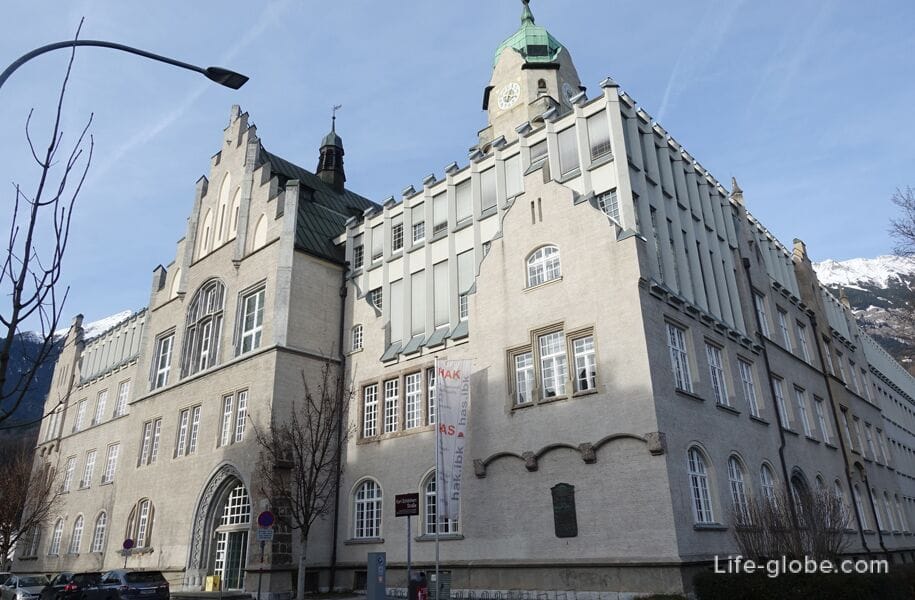
- Church of Christ (Chiristuskirche) is an evangelical church built in 1905-1906. However, the foundation of the evangelical community in Innsbruck arose much earlier than the construction of the shrine - in 1875. Since 1879, the evangelists used the chapel of a former elementary school on Kibahgass Street as a church.
Not only the architecture of the church attracts attention, but also the landscape of the area, which together create a very picturesque picture.
Address: Richard-Wagner-Straße, 4;
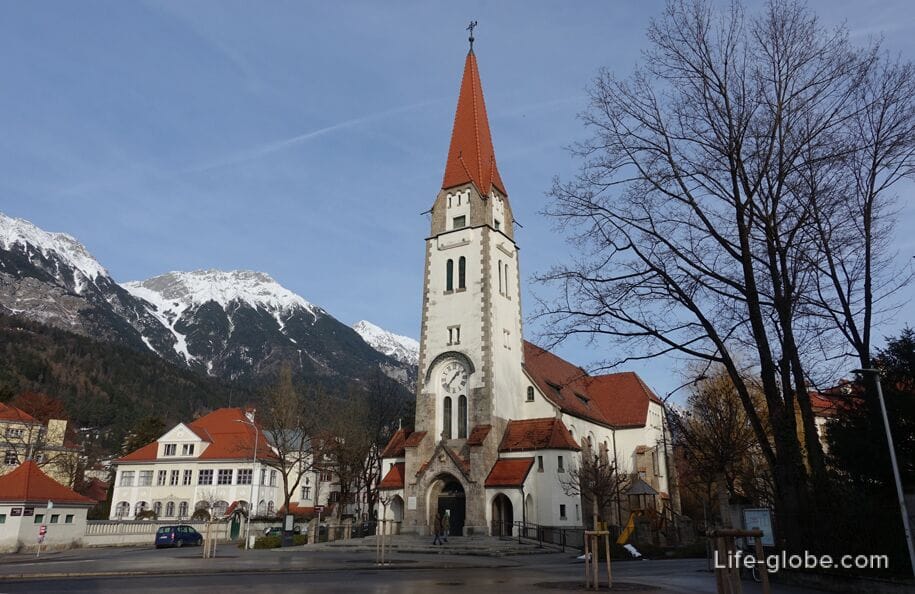
- The historic building of the Federal Railways Authority (Bundesbahndirektion).
Address: Claudiastraße, 2;
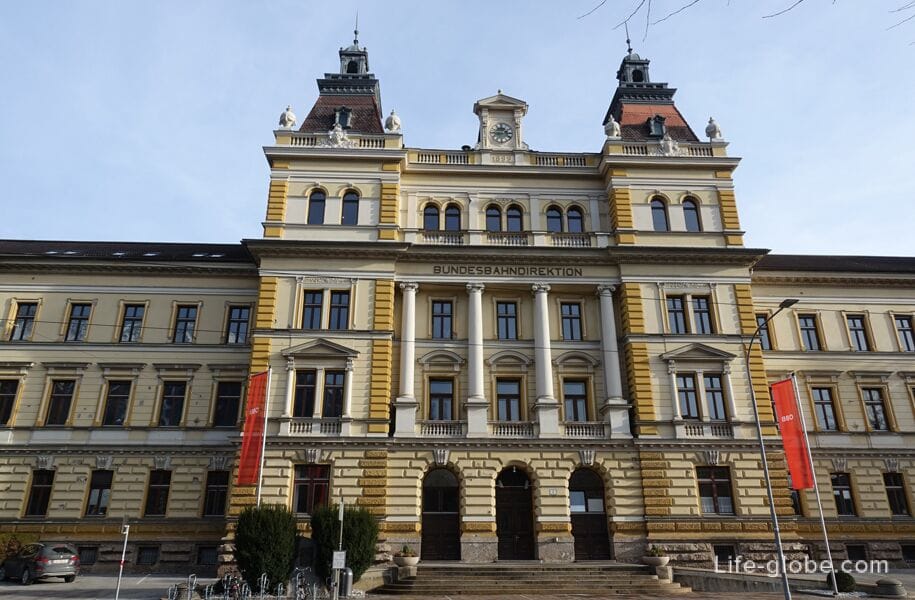
- Tyrol Museum of the History of Culture (Zeughaus, Museum im Zeughaus), located in a historic building - the former arsenal of Maximilian I, built between 1500 and 1506. The halls on the ground floor housed the Emperor’s heavy weapons, and the remaining ammunition was stored on the top floor. The building was used until 1955 as a military arsenal. In 1973, it was opened as a museum of Tyrolean regional heritage.
The current museum presents a collection of geology and mineralogy of the country; typical objects from different historical eras: mining, religion, the Napoleonic era, the 19th century with the advent of tourism and world wars.
Museum site: tiroler-landesmuseen.
Address: Zeughausgasse, 1;
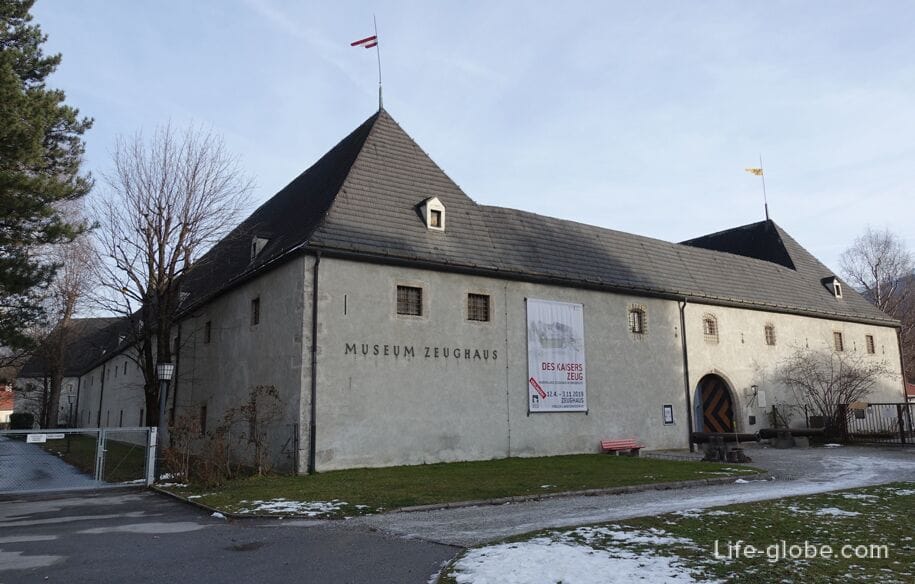
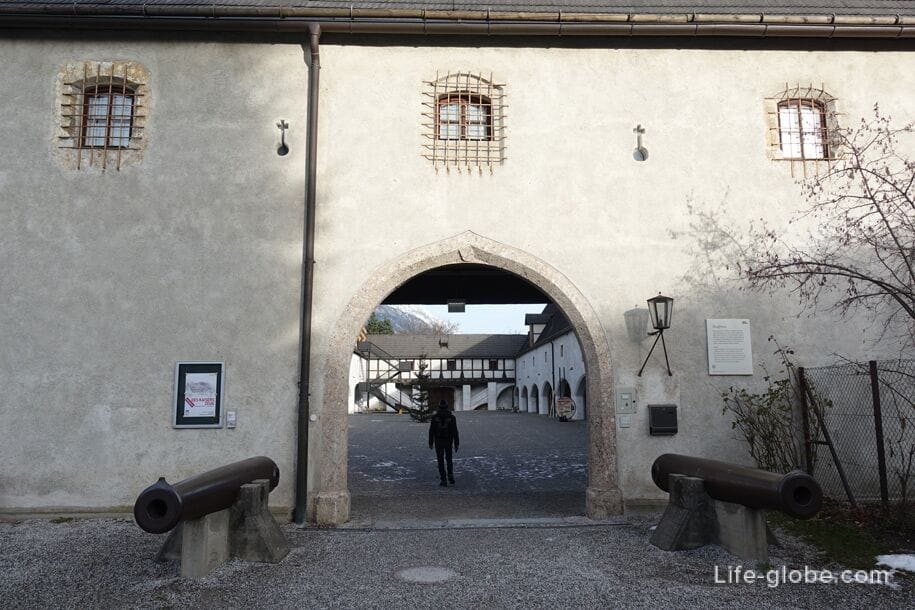
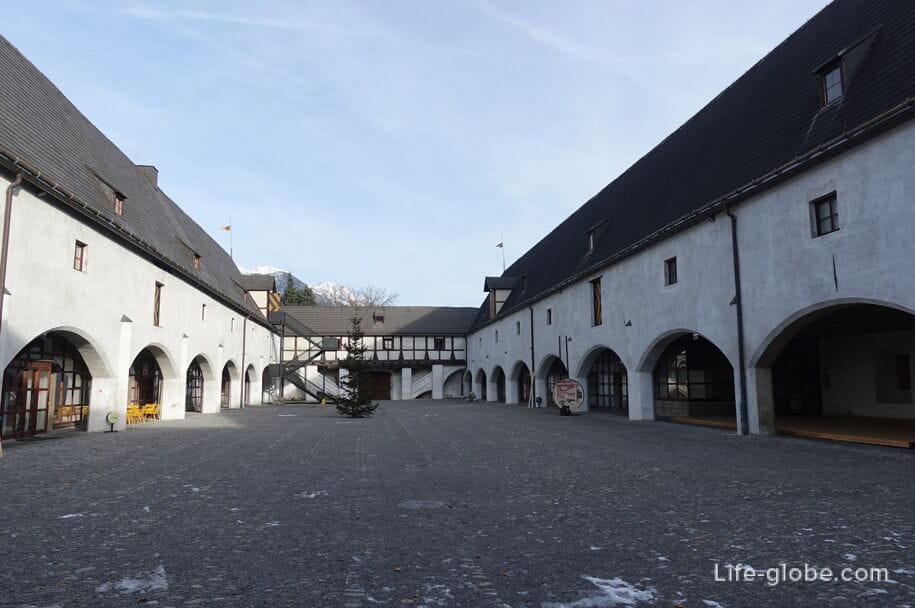
- St. Paul's Church (Pauluskirche) - a Roman Catholic parish church built from 1959 to 1960 for the new district of Innsbruck, erected due to the increase in the population of the city. The church is dedicated to the apostle Paul.
The church is striking thanks to a very high clock tower.
Address: Reichenauer Straße, 68;
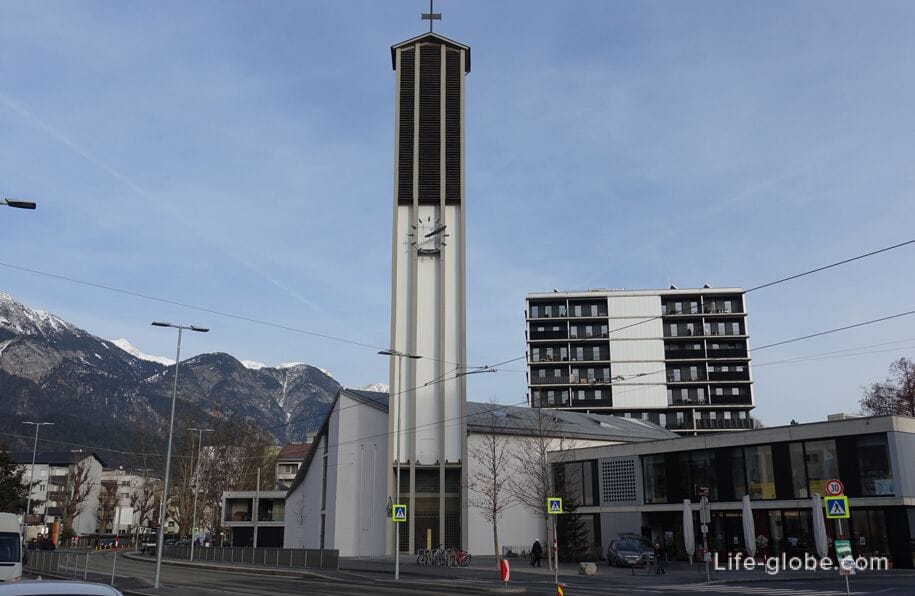
- Rapoldi City Park (Stadtpark Rapoldi), which is a very famous and popular park in Innsbruck with lush vegetation and a pond.
The park offers a wide selection for sports, games or recreation. It is equipped with a sports ground, climbing pyramids, swings, a labyrinth, seating areas, a decorative fountain, a slack area, etc.
Address: Körnerstraße.

Nordkette Lift
The Nordkettenbahnen ski lift is not only a popular attraction and attraction in Innsbruck, but also the opportunity to reach the top of the mountain (altitude about 2,300 meters) and the Hafelekar observation platform - the southern mountain range in just 20-30 minutes from the city center Austria's largest natural park Karwendel.
The lift has three means of transportation - a funicular and two cable cars. You can get from the center of Innsbruck to the highest station by climbing in three stages with two transfers.
In winter, the ski lift is the heart of the Innsbrucker-Nordkettenbahnen ski area, and in the warmer months, hiking trails run from cable car stations and there are places for climbing. Learn more about the Nordkette...
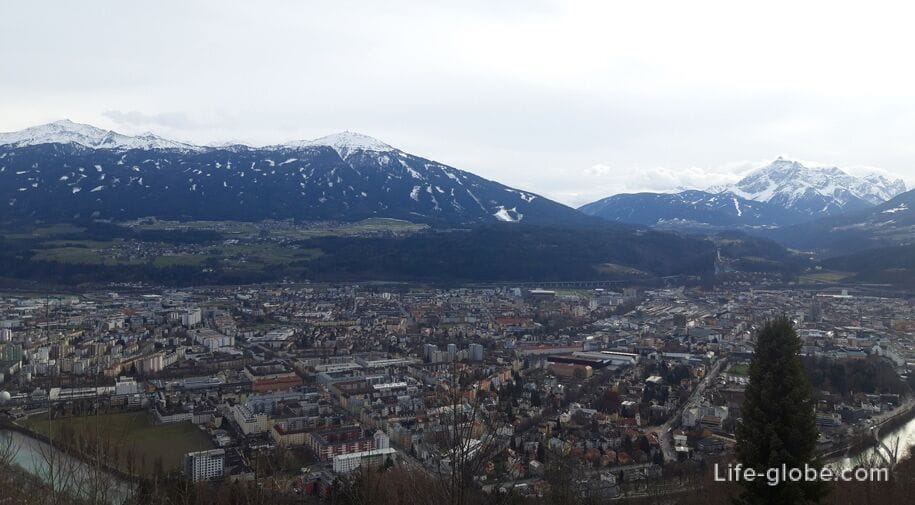
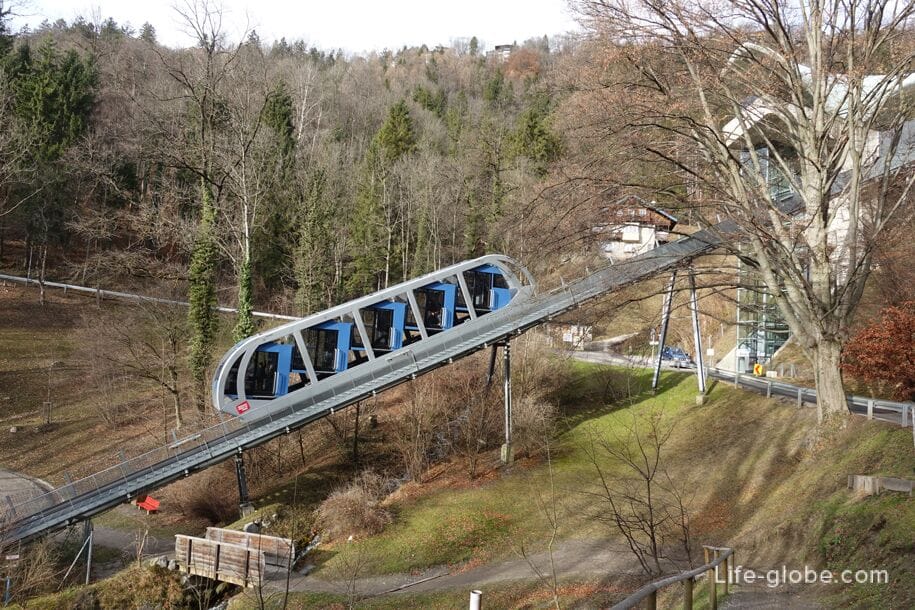
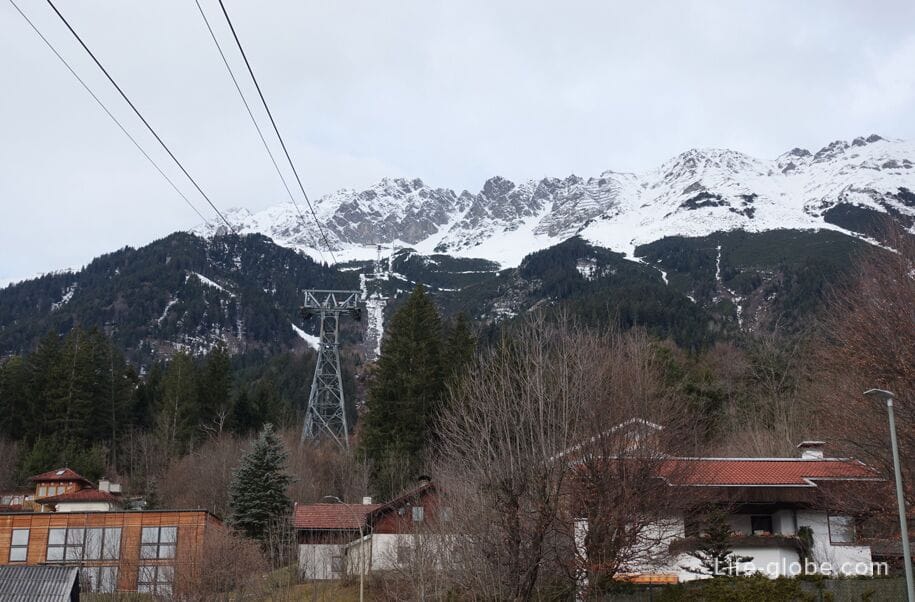
Bridges and Quays of Innsruk
The quays of Innsbruck's center along the Inn River are notable for historic buildings.
Particularly attractive are those buildings that are located on the left (north) side of the river. They are distinguished by bright facades, behind which the peaks of the Tyrolean Alps rise, which creates a picture of unsurpassed beauty. This panorama is depicted on many postcards, souvenirs, as well as in brochures and guidebooks in Innsbruck.
The left and right sides of the Inn River are connected by several bridges, the most visited of which is the Inn Bridge, which connects the historic center of Innsbruck, spread on both sides of the river.
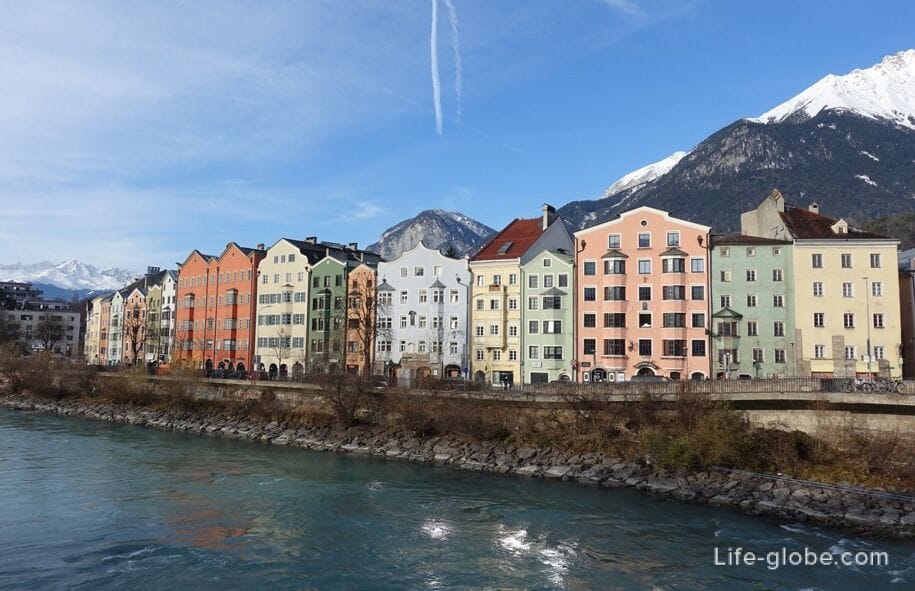
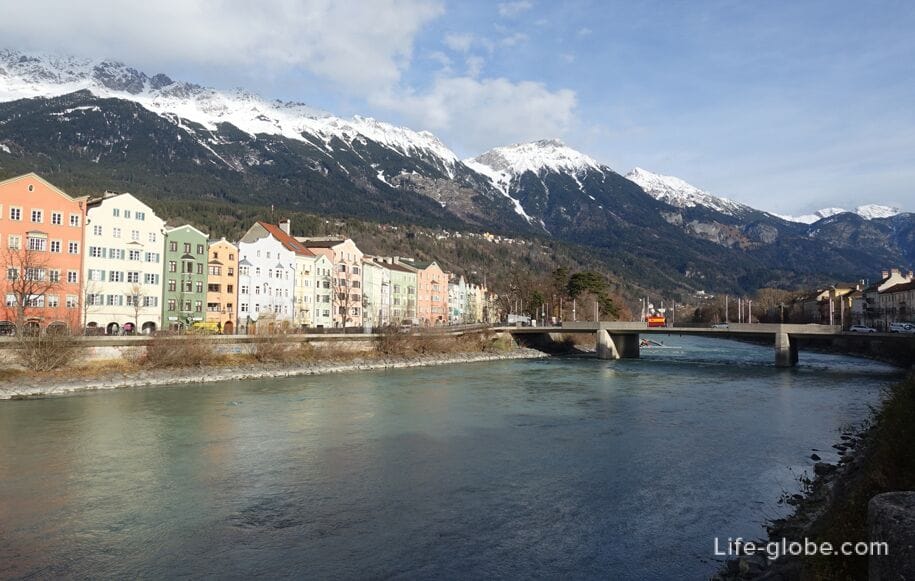
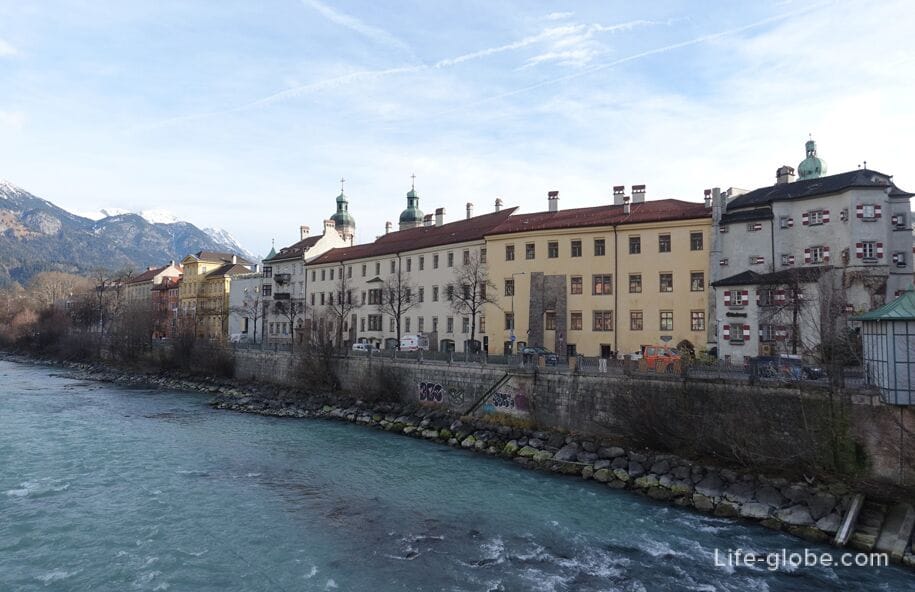
North side of Innsbruck (relative to the Inn River)
Like the center of Innsbruck, the north side of the city, relative to the Inn River, attracts tourists with its historical sites and viewing platforms, as well as hiking trails running through nature parks.
Sights of the northern part of Innsbruck:
- Mariahilf-St. Nicholas district (Mariahilf-St. Nikolaus - Mariahilf St. Nicholas), which extends in a narrow strip along the Inn River, parallel to the Old Town of Innsbruck, located on the opposite - right side of the river.
The Mariahilf-St. Nicholas district is the oldest part of Innsbruck, it was founded as a village around 1165.
Main attractions of the area : Innstraße street, which is the main and largest street in the area; Waltherpark (Waltherpark) with a playground, places to relax and a monument to Walther von der Vogelweide (Walther von der Vogelweide); the small square Hans Brenner Platz, which houses the historic fountain-well; Mariahilfkirche Church and St. Nicholas Church (Pfarrkirche St. Nikolaus), which is the main and most beautiful shrine of the area. Learn more about the Mariahilf-St Nicholas area...
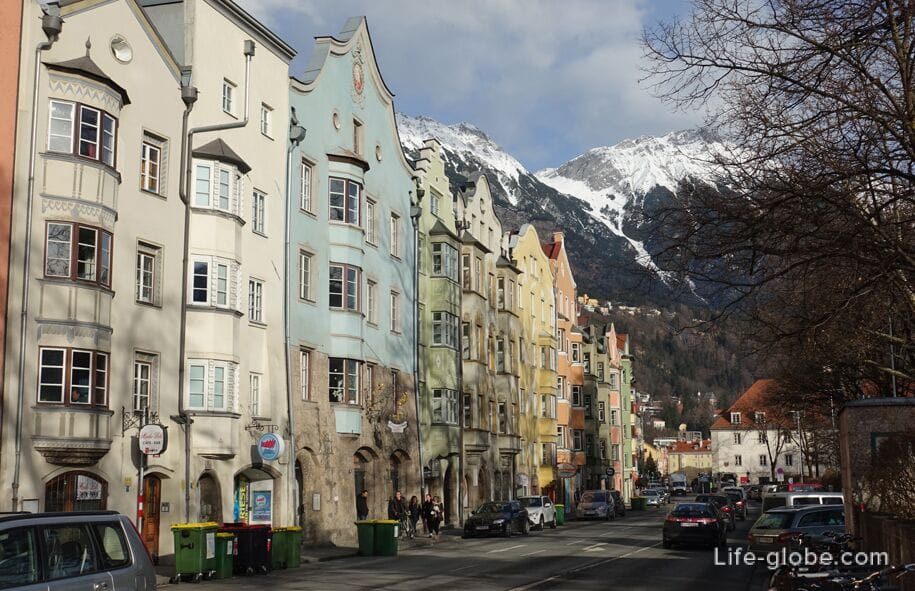
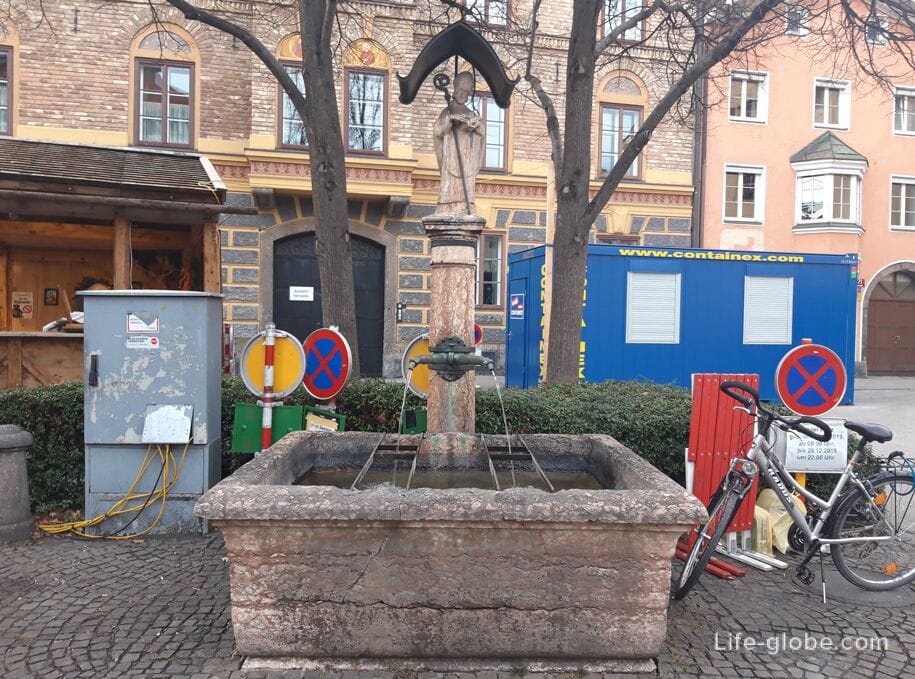
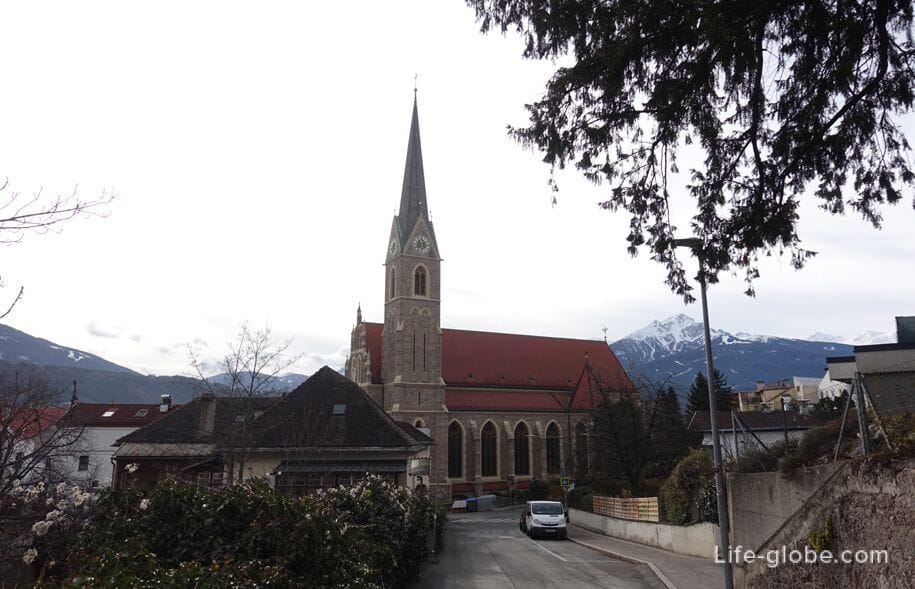
- Botanical Garden of the University of Innsbruck (Botanischer Garten des Institutes für Botanik der Universität Innsbruck) which grows more than 7,000 species of various plants from different habitats, including alpine mountain plants, medicinal, poisonous and aromatic plants, as well as plants from rainforests and subtropical arid regions.
Botanical Garden Site: uibk.ac.at/botany/botanical-garden.
Address: Sternwartestraße, 15;
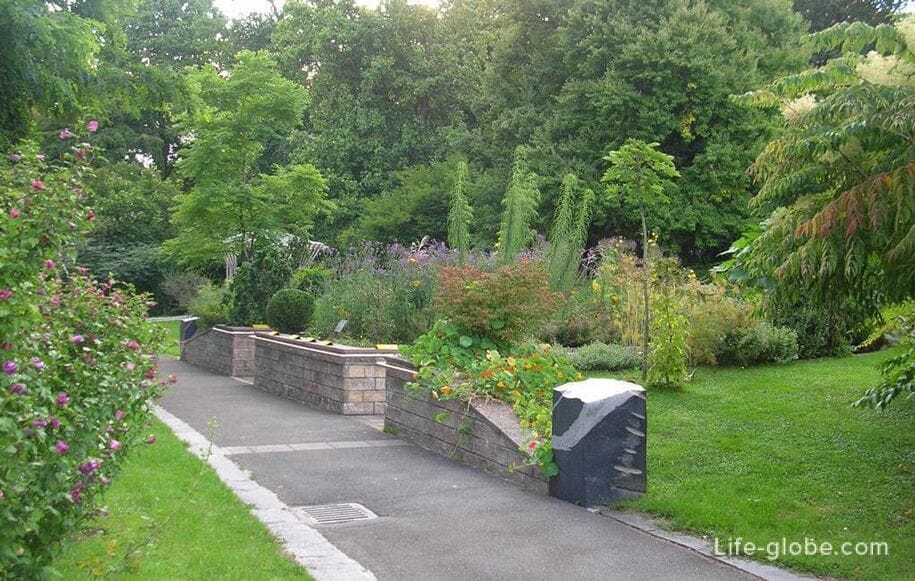
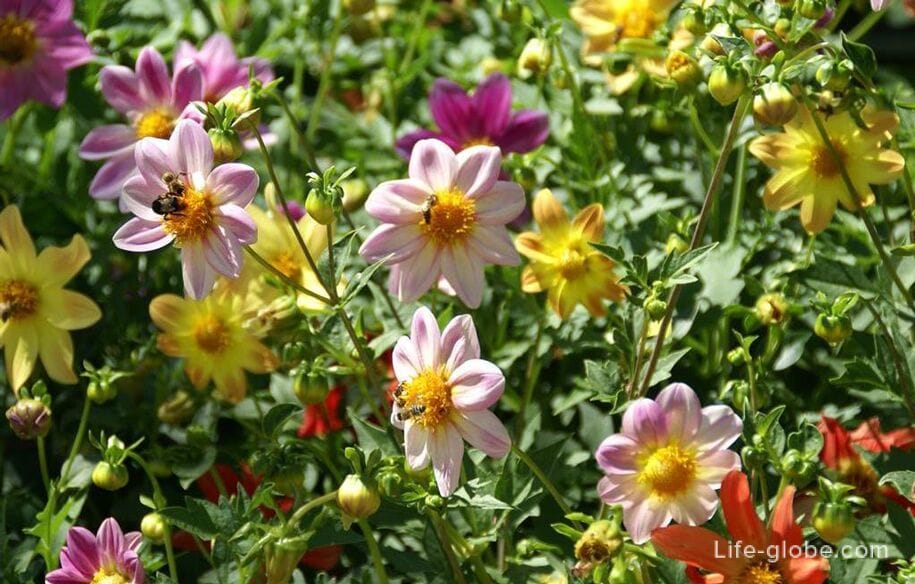
- Innsbruck Alpine Zoo (Alpenzoo Innsbruck), which is considered the highest thematic zoo in Europe. The zoo is located at an altitude of 750 meters above sea level.
In Alpenzoo, about 2,000 alpine animals (about 150 species) live on the territory of just over 4 hectares in natural enclosures, terrariums and aquariums.
The highlight of the zoo is that it shows the most complete collection of wildlife from the alpine region.
Zoo website: alpenzoo.
Address: the zoo is located at the foot of the Nordkette, at 37a Weiherburggasse.
From the center of Innsbruck to the zoo you can get on the funicular of the Nordkette lift, on foot or by car (Rent a car in Innsbruck...) or the bus line W. There are places for parking a car near the zoo;
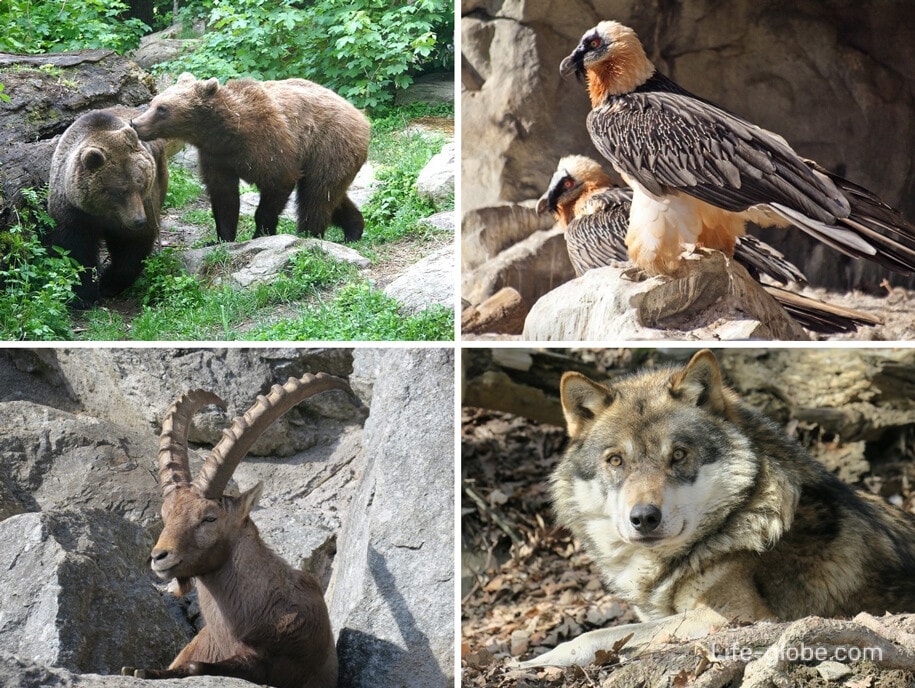
- Weiherburg Castle (Schloss Weiherburg) or Pond Castle - a late Gothic building whose name refers to the fish pond that existed before 1911.
With the relocation of Prince Frederick IV from Meran to Innsbruck in 1420, nobles and wealthy citizens began to build numerous residences in the vicinity of the city. This castle residence was built around 1460 by Christian Tianzl, whose family became rich in silver mining.
Around 1480, Tianzl sold the castle to the Tyrolean prince Sigismund. Later, the building was replaced by several owners, as a result of which it was modified and expanded. After the building became the property of the city of Innsbruck in 1911, the building was restored in 1976-1978 and today the castle serves as a representative building for cultural and social events.
Address: the castle is located at the entrance to the Alpine Zoo, at the address: Weiherburggasse, 37;
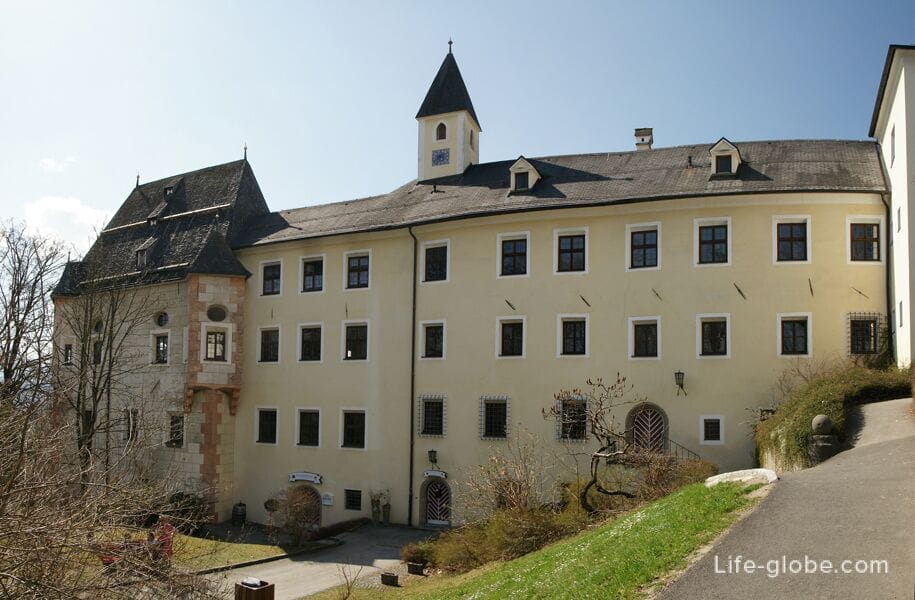
- Höttinger Church, is the new Höttingen Church. It was built in the style of historicism in 1911.
Near the main portal of the church is a monument - the Hötting War Memorial (Kriegerdenkmal Hötting).
Hötting was previously an independent municipality, until in 1938 it was included in Innsbruck and is now one of the districts of the city.
Address: Schulgasse, 2;

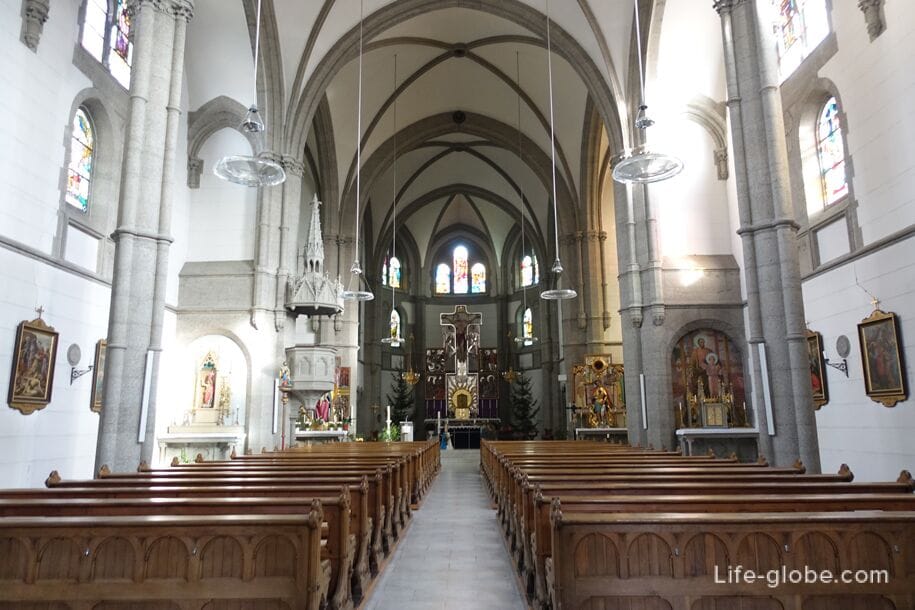

- the old Höttinger parish church (Alte Höttinger Pfarrkirche) is the forerunner of the new Hettinger church.
The Gothic church building was first mentioned in 1286, and then decorated in the Baroque style. The round fortified tower of the shrine is visible from afar.
Near the church there is a small platform with panoramic views.
Address: the church is located at the intersection of Schulgasse and Steinbruchstraße;

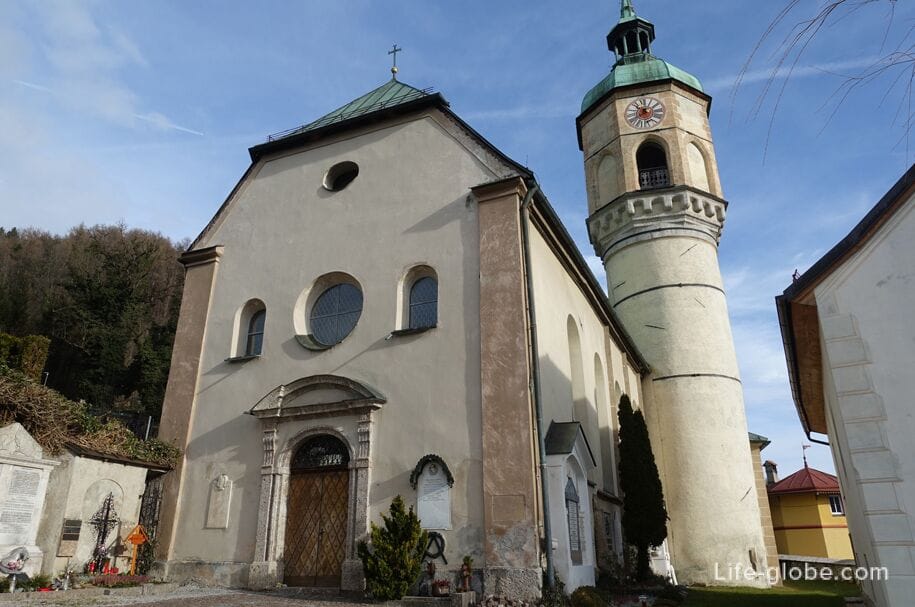

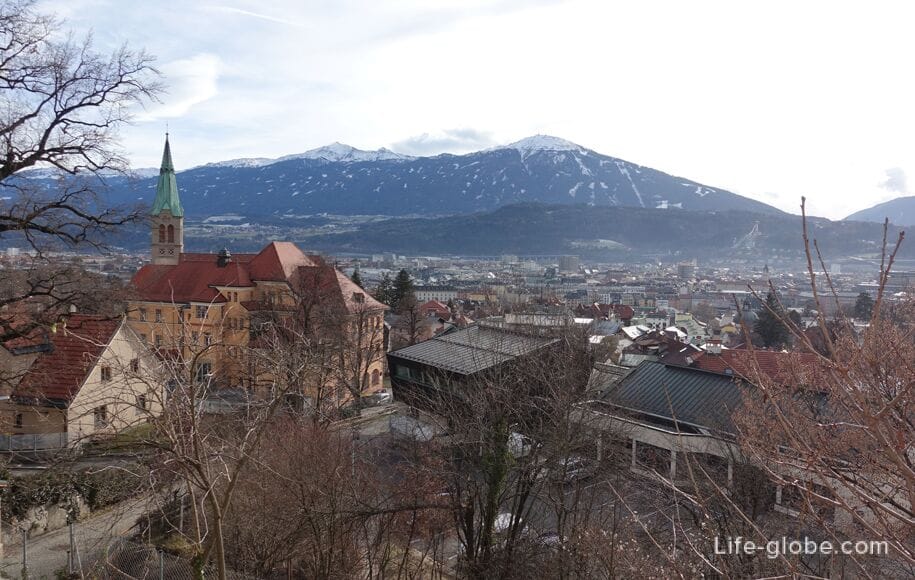
- tower house of the Masters of Hötting (Wohnturm der Herren von Hötting). The eastern part of this building is the remains of a medieval tower house that belonged to the Masters of Hötting and was destroyed during the 1689 earthquake.
Since about 1454, in the western part of the building there were a bell tower and an arms factory of the Endorfer family, marked by a stone cannonball inserted into the outer wall.
Address: the building is located near the old Höttinger parish church, at the intersection of Schulgasse and Steinbruchstraße;
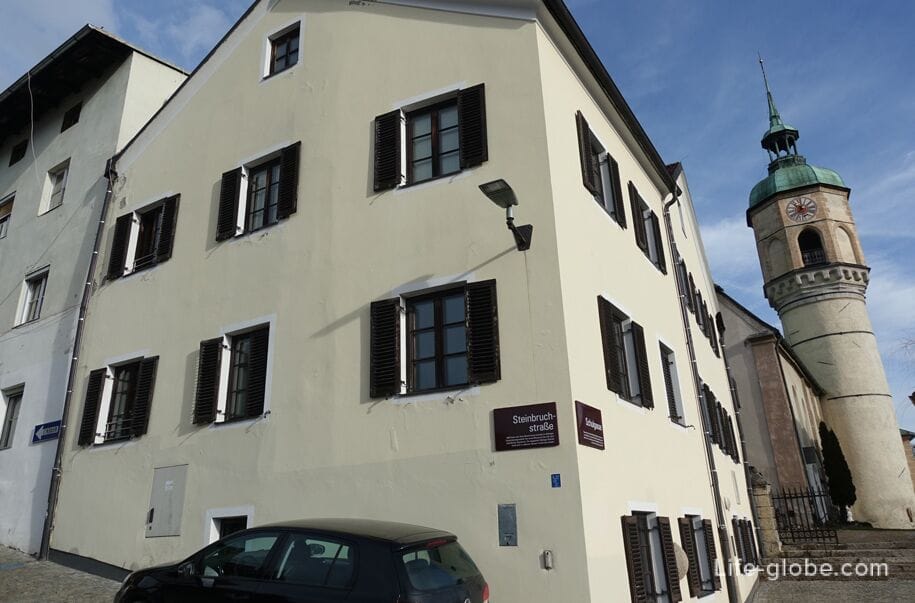
- Buchsenhausen Castle (Schloss Büchsenhausen). The apartment building for Gregor Loeffler was built on this site in 1538, probably by Gregor Turing, and acquired its current size in 1641, when it was bought by Chancellor Wilhelm Biner.
Around 1700, the building was rebuilt, presumably according to the plan of Johann Martin Gumppp the Elder. At this place was a brewery (from 1642 to 1924) and the first public outdoor pool in the city (from 1852 to 1962).
Today, Buchsenhausen is a graduate school for production, research and communication in the field of visual arts and art theory.
Castle Address: Weiherburggasse, 13;

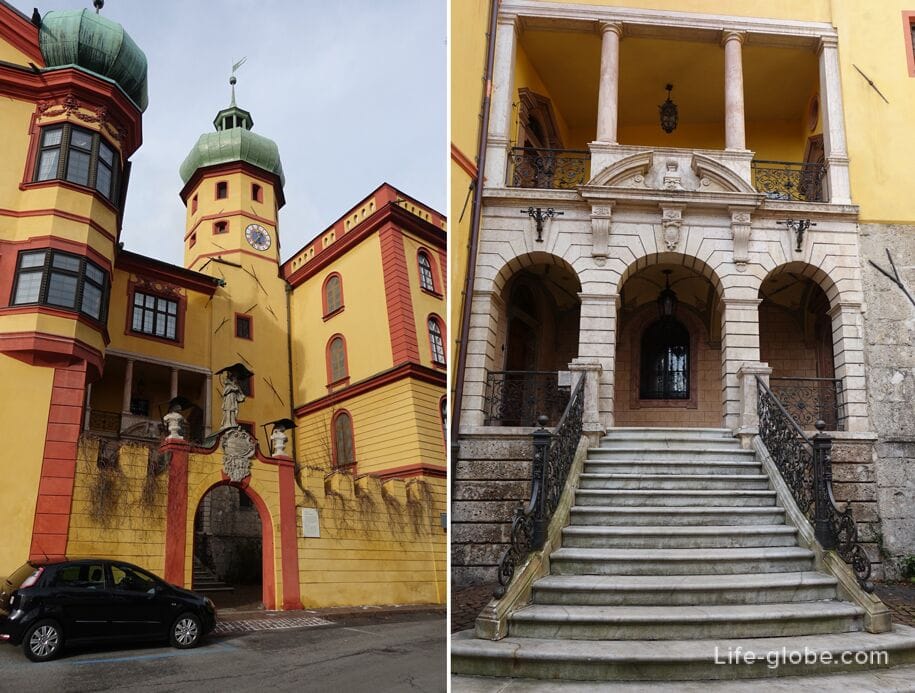
- St. Leonard’s Parish Church or the church of the Mühlau district (Pfarrkirche St. Leonhard / Die Mühlauer Pfarrkirche). The first construction of the Gothic church was completed in 1432. The church was replaced by a larger baroque building in 1748. The frescoes on the ceiling and the elevation of the facade of the shrine in the Baroque style were executed by Johann Michael Strickner (1749). The facade acquired its current appearance in 1880.
The church is dedicated to Saints Anthony and Leonard. Both saints are represented in the church both on a high altar in the form of large wooden statues, and in a picture on the side altar.
Near the church there is a small cemetery and an observation deck.
Address: Schloßfeld, 2;



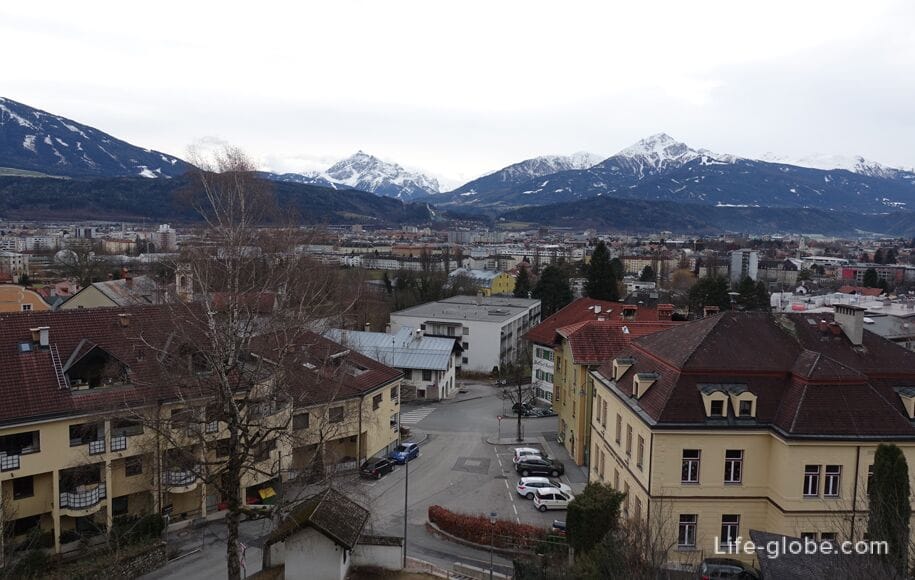
- Carmelite Monastery - Carmel St. Joseph and Theresa (Karmel St. Josef und St. Teresa).
The monastery was founded in Innsbruck (in Wilthen) in 1846 and was originally located in a building surrounded by fields. Soon, in the midst of a fast-growing city, in 1856 the monastery already ceased to be a secluded place and found itself near the railway station and surrounded by new buildings. Since this place no longer met the needs of the Carmelites, in 2004 the monastery moved to a new building designed by Margaret Hubacher-Sentobe and located above the Mühlau district, on the slope of the Nordkett.
After the sisters moved, the monastery buildings in Wilthen were demolished in 2004, and residential buildings were built in their place.
Half of the new monastery is surrounded by greenery near the slope and is surrounded by a vast garden. A spacious complex of buildings is located around a central square courtyard based on a traditional cloister.
The temple of the monastery was erected as a separate building and has a bell tower with the coat of arms of the Carmelites.
Address: Karmelweg, 4.

In addition to the above, within the northern side of Innsbruck (relative to the Inn River) there are also other churches, chapels, chapels and historic buildings.


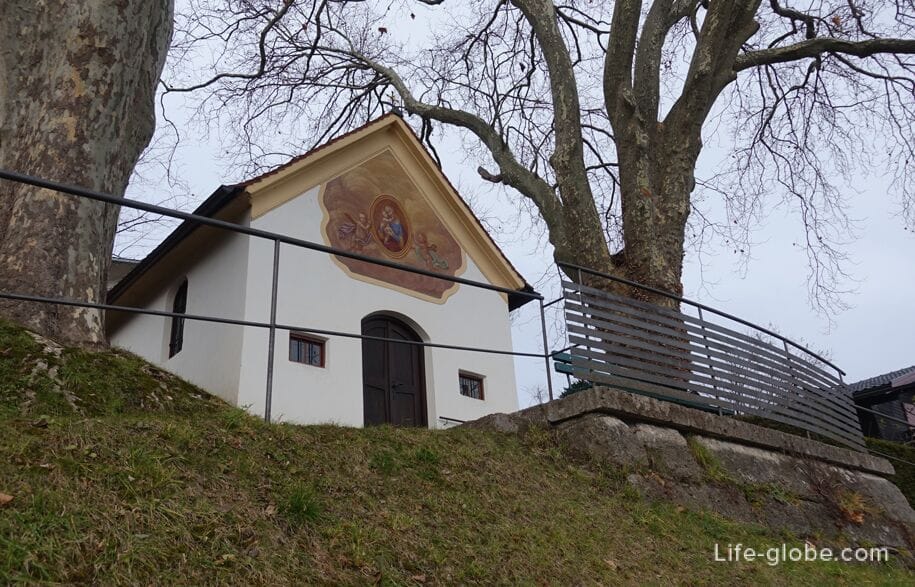
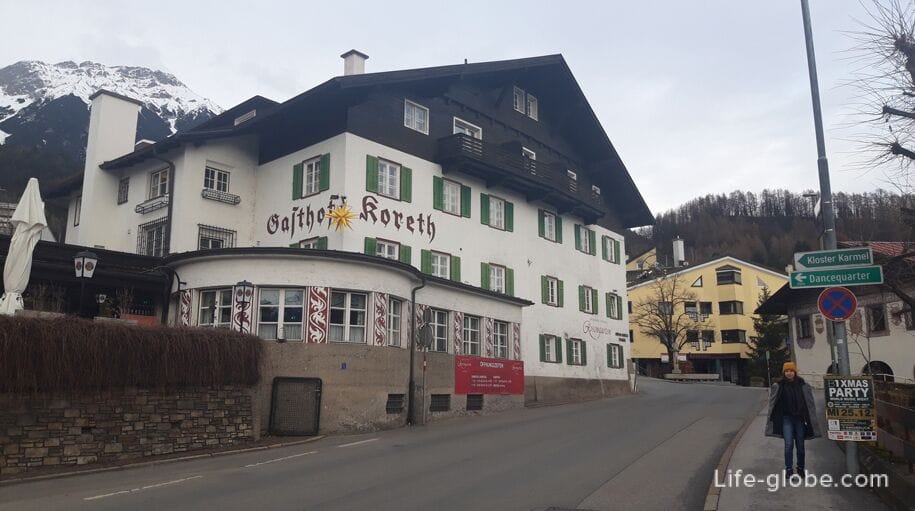

The northern side of the city of Innsbruck has a sloping (mountainous) topography with abundant vegetation. For this reason, there are nature parks in the area, hiking and cycling trails, and panoramic views of Innsbruck, mountains and surroundings from many points. Learn more about Innsbruck viewing platforms...
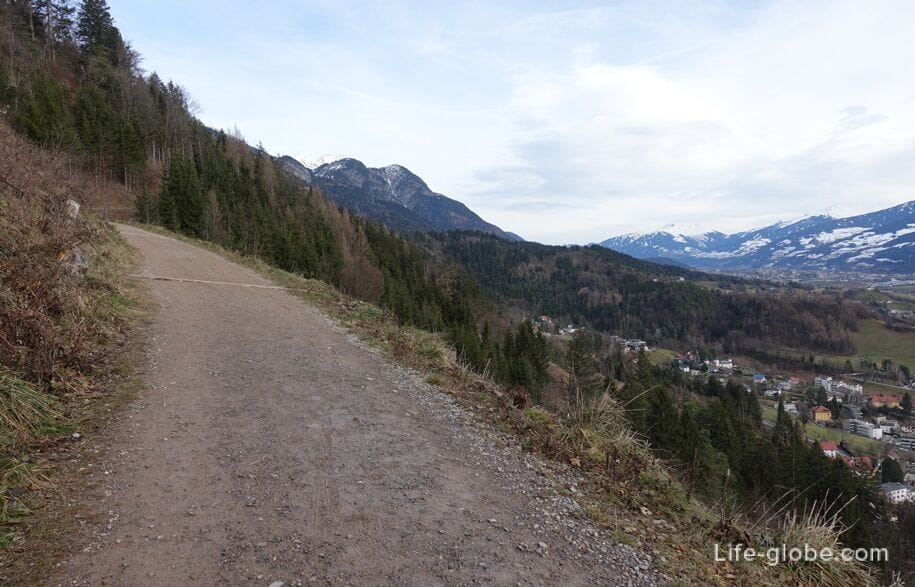
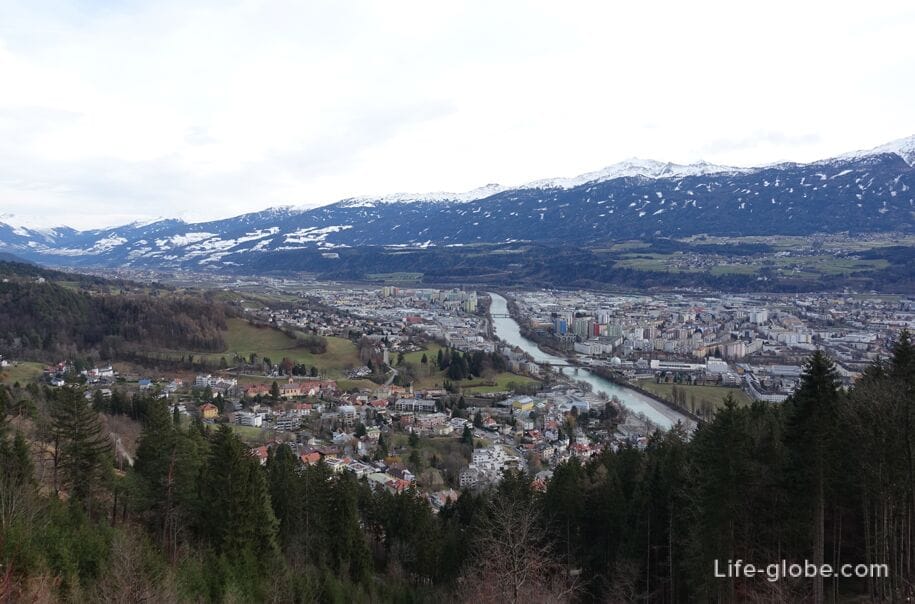

Ambras Castle
Ambras Castle (Schloss Ambras) is one of Innsbruck's most important and popular attractions.
Its cultural and historical significance is inextricably linked with the personality of Archduke Ferdinand II, who founded the first collections of Ambras and for which, on his initiative, a museum was erected.
Today the castle is a museum complex with a landscaped park, courtyard, chapel and several buildings that house galleries, exhibition rooms with collections of glass, Gothic sculptures, portraits of the princely rulers of Tyrol, weapons, antiques, books, etc.
Ambras Castle Site: schlossambras-innsbruck.
Address: the castle is located on a hill on the southeastern outskirts of Innsbruck, at: Schloßstraße, 20. Read more about Ambras Castle and Museum…
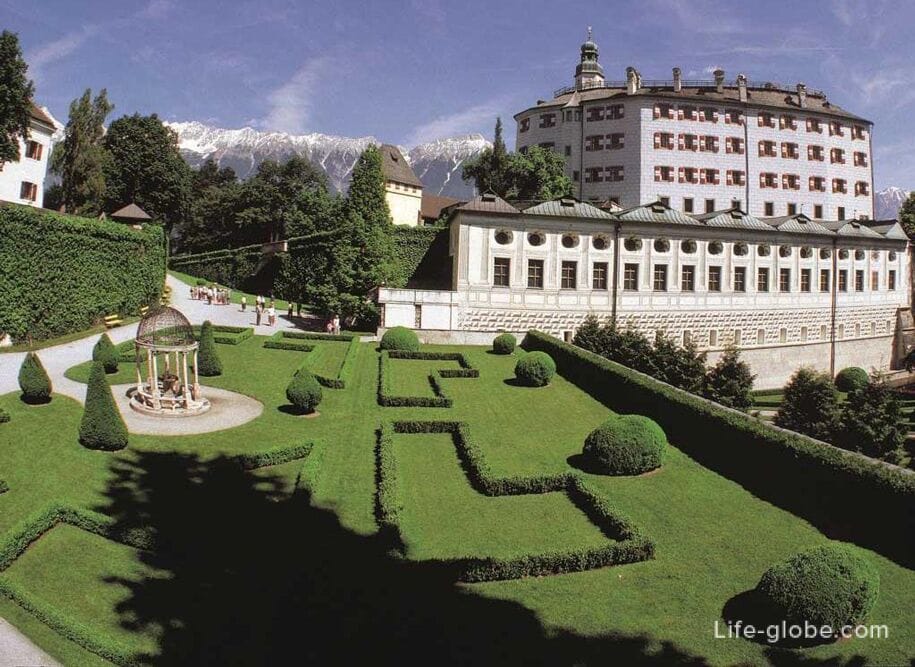
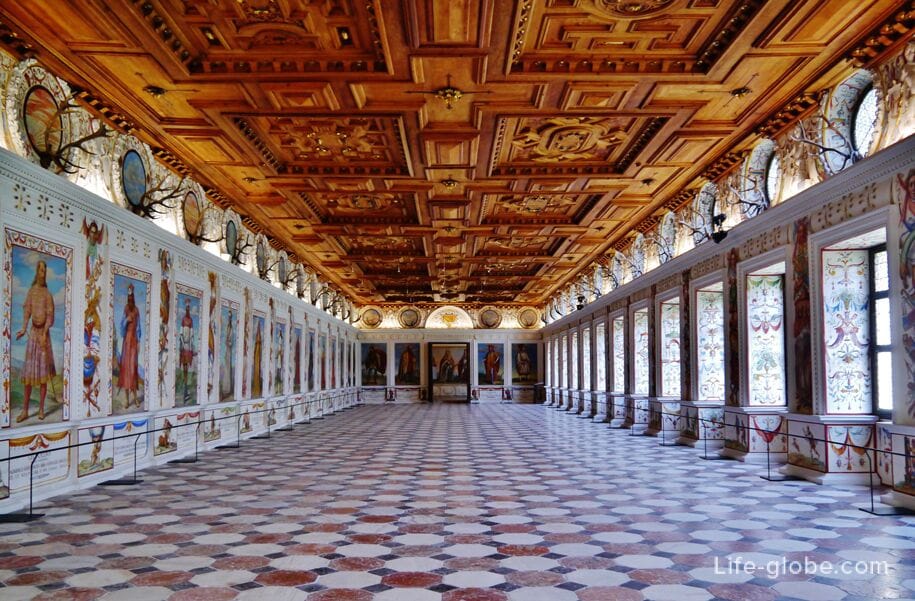
Regional Sports Center
The multifunctional sports complex OlympiaWorld (OlympiaWorld-Landessportcenter) was opened in 1963 and served as an Olympic Park at the 1964 and 1976 Winter Olympics, as well as in 2012 at the Winter Youth Olympic Games.
Complex website: olympiaworld.
Address: Olympiastraße, 10a.
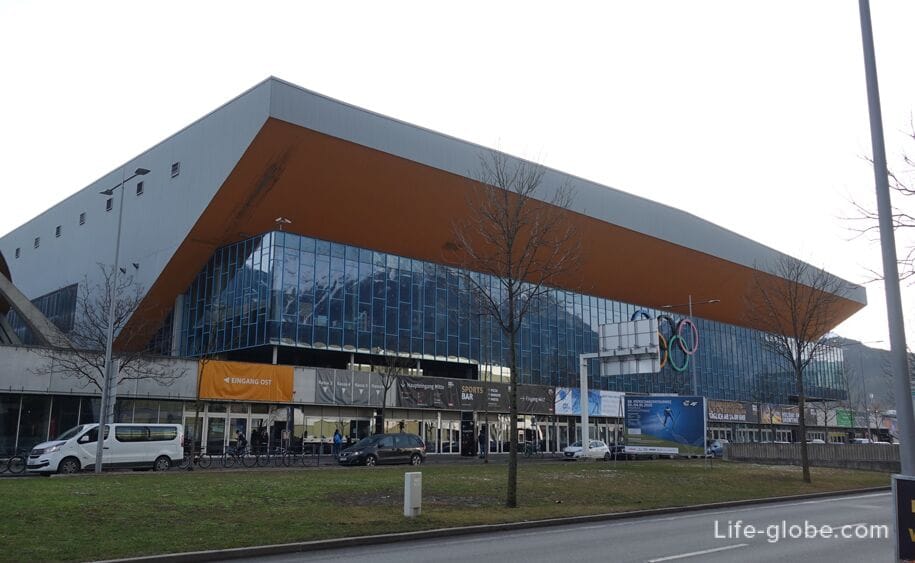
Bergizel Hill
Bergisel Hill, a height of 746 meters, is located in the southern part of the Innsbruck district of Wilten.
In 1809, Bergisel was the site of the legendary battle - four battles (the Bergisel battles) during the Tyrolean uprising under the command of freedom fighter Andreas Gofer.
Currently, Bergisel Hill is not only a historical place, but also a place of recreation, hiking trails and a place where on the hills are some of the significant sights of Innsbruck, including observation decks (observation points) and the Bergisel Museum.
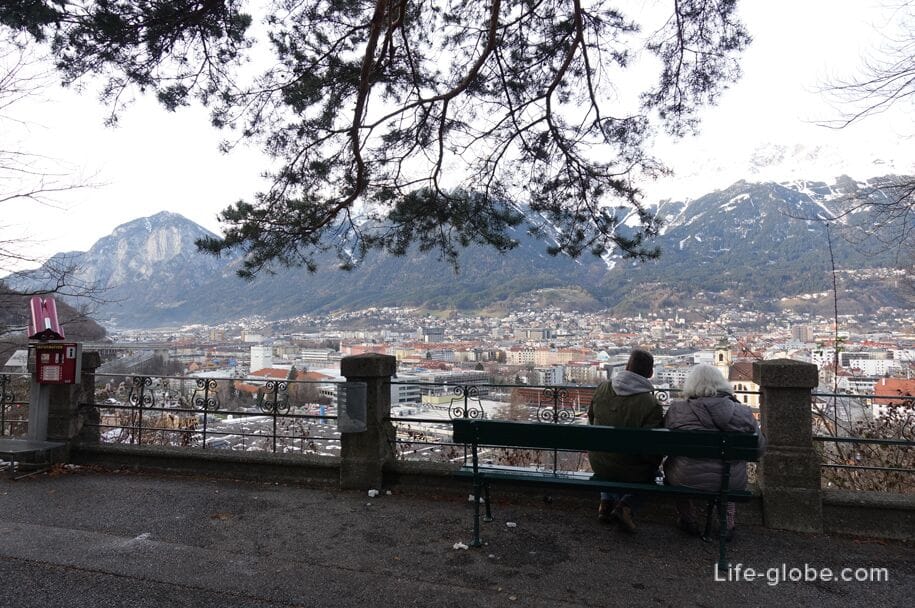
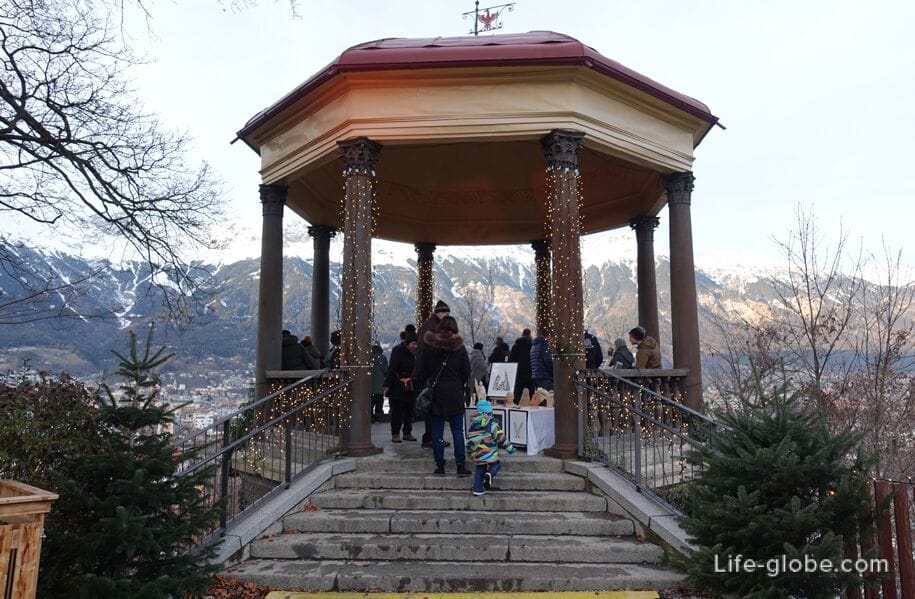
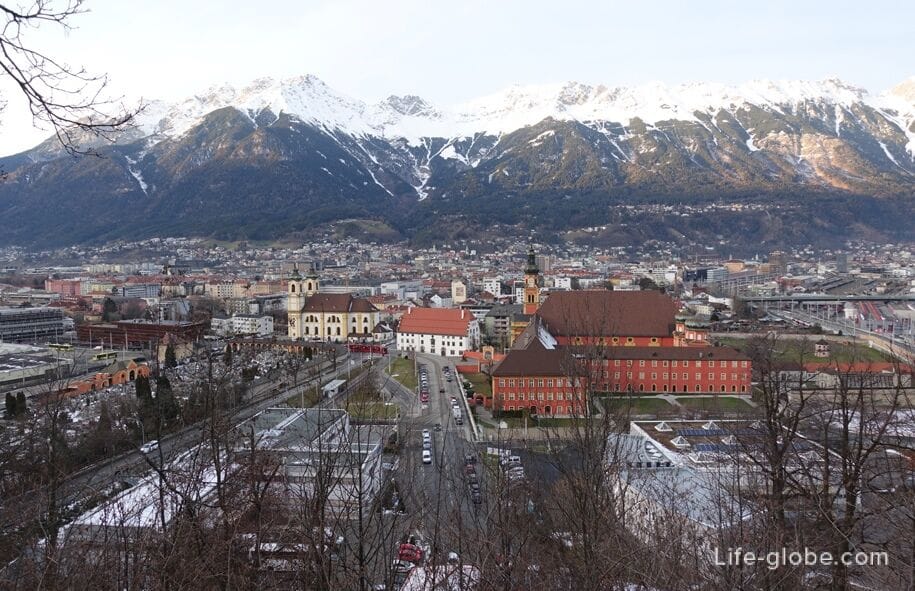
The main attractions of Bergisel Hill:
- Bergisel ski jump (Bergiselschanze, Bergisel Schanze) with Olympic history, which in its current appearance was built according to the design of Zaha Hadid, who received a prestigious architectural award for her masterpiece.
The Bergisel Sky panoramic restaurant with glass floor-to-ceiling facades and an observation deck (panoramic terrace) provide a breathtaking view of Innsbruck and the surrounding area in the high spring tower.
Springboard site: bergisel.
Address: Bergiselweg, 3;

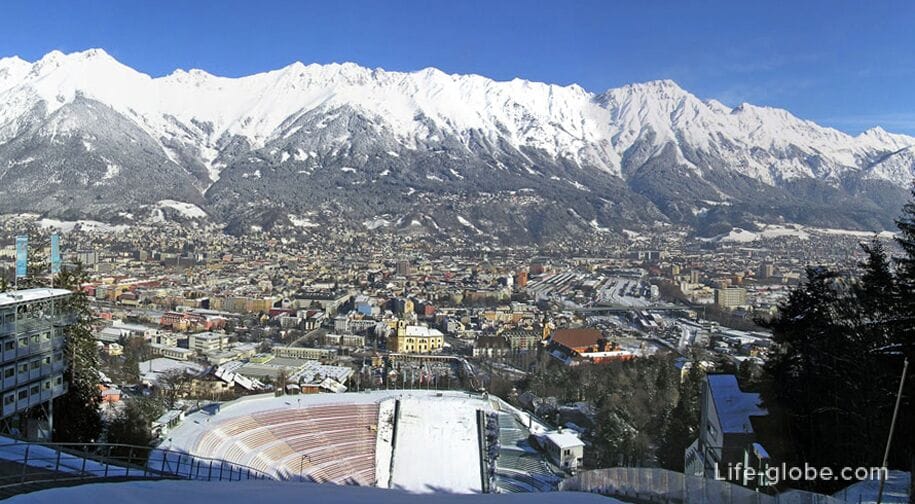
- the regimental museum of Tyrolean imperial shooters - Kaiserjäger Museum, known as the Bergisel Museum (Kaiserjägermuseum) and the new building - Tyrol Panorama which also houses the museum (Tirol Panorama Museum), which are a single complex of the military-historical museum of Bergisel.
The masterpiece of the museum is a large panoramic picture reflecting the Tyrolean struggle for freedom on August 13, 1809, depicting events on 1,000 square meters in a 360-degree view.
The Panorama Museum, among other things, also includes the Schauplatz Tirol permanent underground exhibition hall and access to the Kaiserjager Museum.
Museum site: tiroler-landesmuseen.
Address: Bergisel, 1-2;
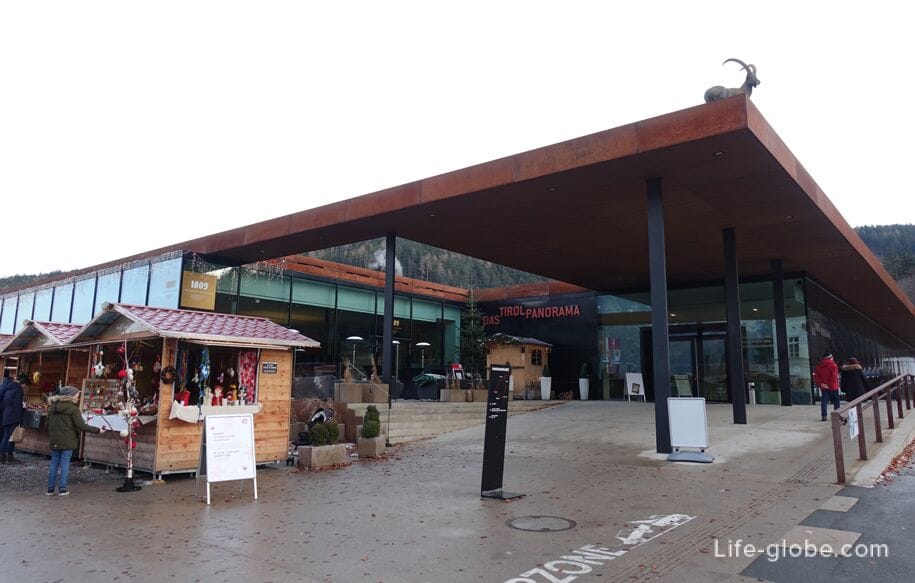
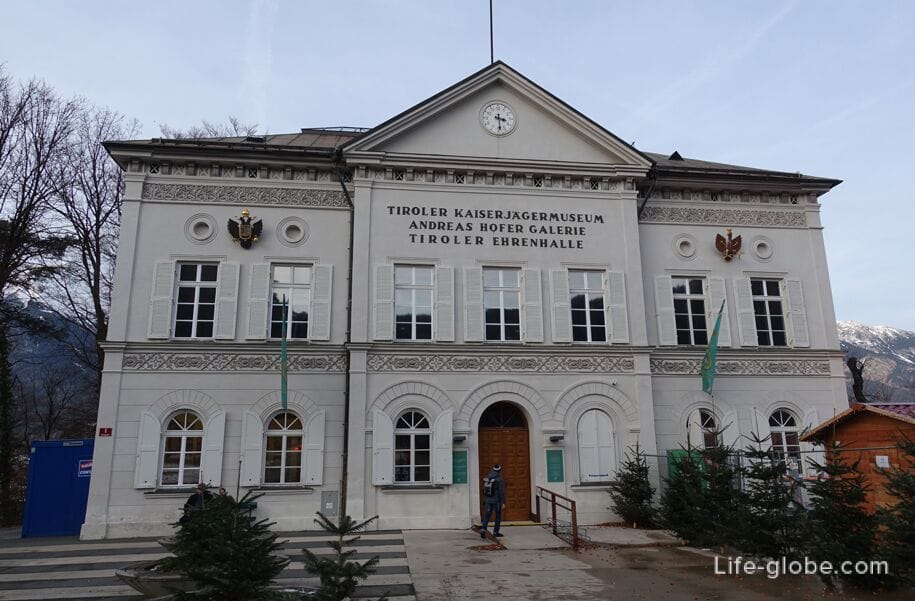
- Bergisel panoramic tour (Panoramarunde Bergisel) - equipped walking circular route that runs along Bergisel and has several observation points (observation platforms), including the hill, gorge and ski jump Bergisel. Learn more about Bergisel Hill and its attractions...
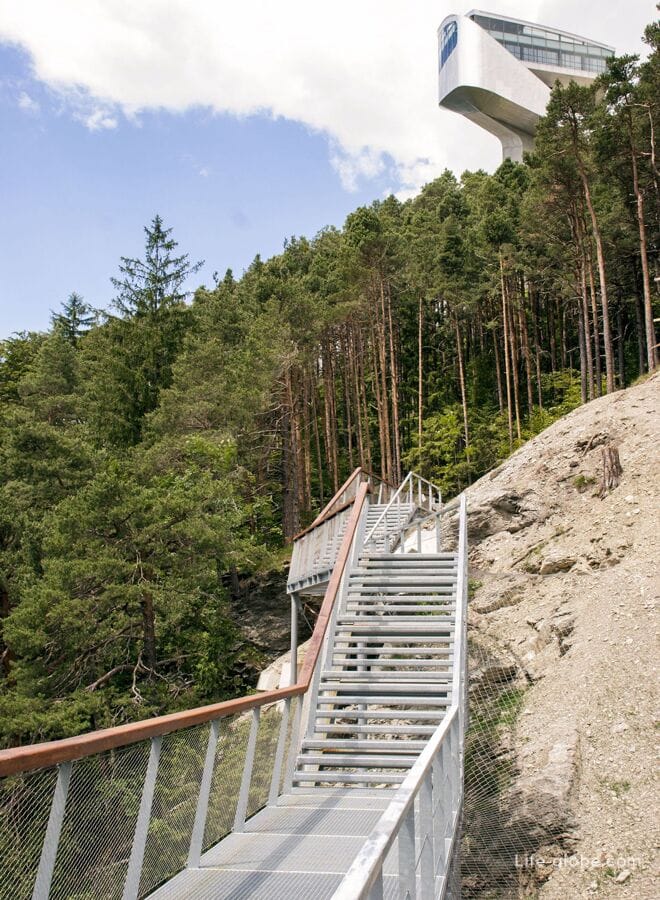
Wilten
Wilten is a statistical district of Innsbruck located in the southern part of the city.
Currently, Wilten is a developed residential area in which there is a railway station, public transport runs in the city, there is a park area for relaxation and relaxation, as well as viewing platforms, museums, casinos and significant sights of Innsbruck.
Attractions in the Wilten area:
- Innsbruck Casino (Casino Innsbruck), which was opened in 1992 and is considered one of the most popular casinos in Austria.
The casino also offers gaming machines, a restaurant, and holds various events: themed gaming nights, cabarets, concerts, charity festivals, lectures, etc.
Casino site: casinos.
Address: Salurner Strasse, 15;
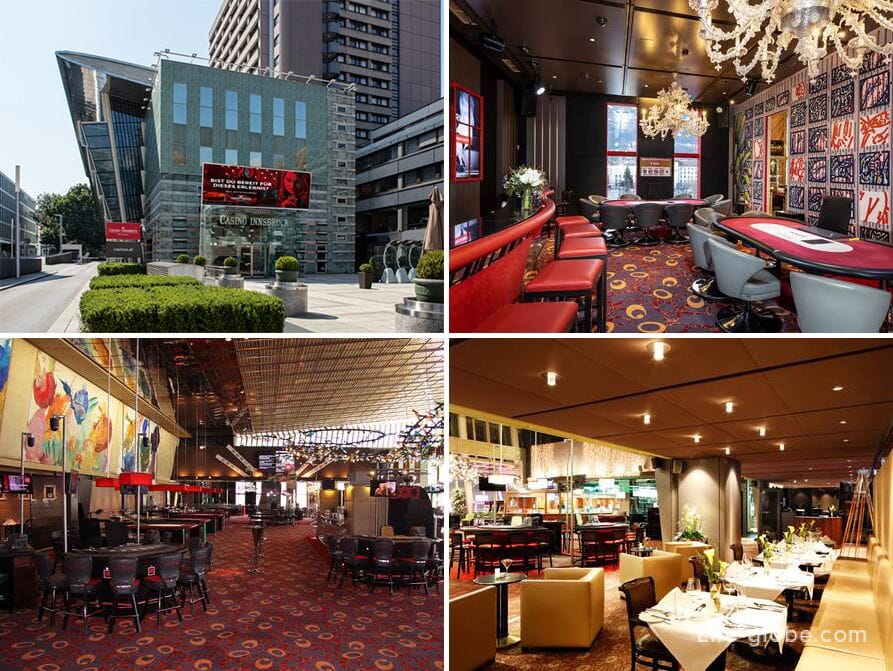
- Wilten Basilica (Wiltener Basilika), also known as the Basilica of Our Lady of the Immaculate Conception, is a Roman Catholic church serving as a parish church and a popular pilgrimage church.
The Church of Our Lady has been registered since 1259.
In 1751-1756, a rococo-style building was erected to replace the already dilapidated church building by that time. And in 1957, Pope Pius XII founded the parish church of Wilten.
The interior of the church is notable for its rich decoration with delicate colors, light but abundant stucco molding, elegant frescoes, the main altar and organ.
Address: Haymongasse, 6a / Pastorstraße, 694;
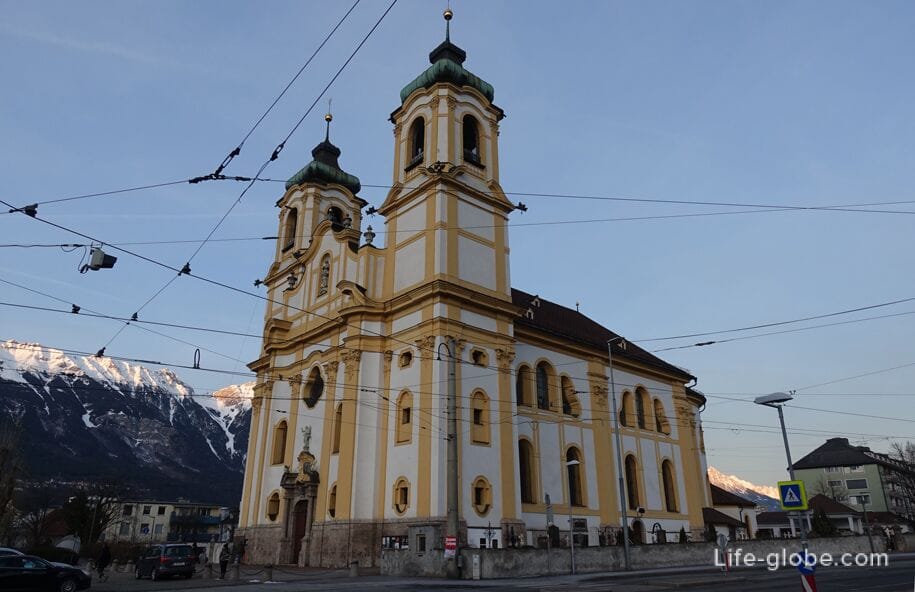

- Wilten Monastery (Wilten Abbey, Stift Wilten) - a monastery of premonstrants founded in 1138 by Bishop Reginbert von Brixen.
The heyday of the monastery was in the 17th and 18th centuries.
The interior decoration of the cathedral church of the monastery stands out for its splendor of baroque, with catchy combining dark and light shades, as well as frescoes, stucco molding, sculptures, the main altar and side chapels.
Address: Klostergasse, 7;

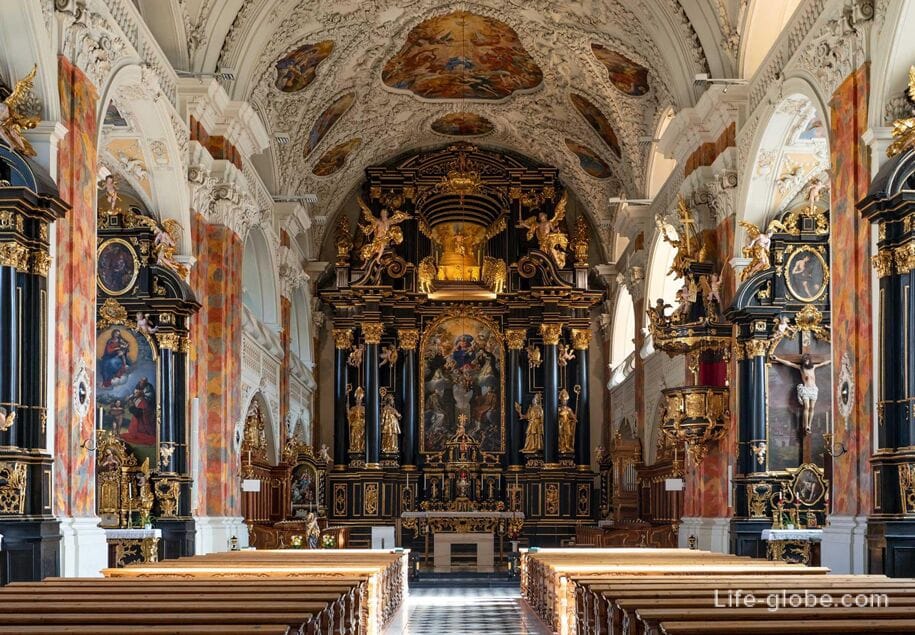
- Grassmayr Bell Museum (Bell Museum of Grassmayr Bell Foundry / Glockengießerei Grassmayr), which tells the story of 14 generation Tyrolean family craft since Mortimer Grassmayr made his first bell in 1599, and where ancient manufacturing methods are combined with new technologies.
The museum presents a combination of the old foundry, the evolution of bells and a sound bell studio.
Today Grassmire bells ring in almost 100 countries.
Museum site: grassmayr.
Address: Leopoldstraße, 53;
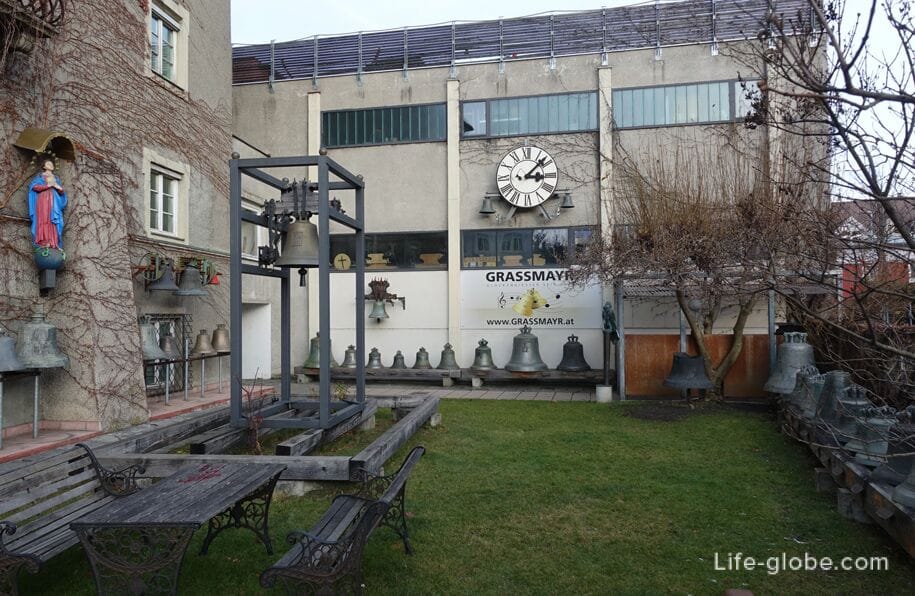
- Tyrol Railway Museum (Tiroler MuseumsBahnen), which tells its guests about the history of the Tyrol railway.
In the museum's collection: old tram cars showing the development of public transport, old trains, as well as images and models located in the old waiting building and in the service area of the former Stubaitalbahn station.
Museum site: tmb.at.
Address: Pater-Reinisch-Weg, 4;
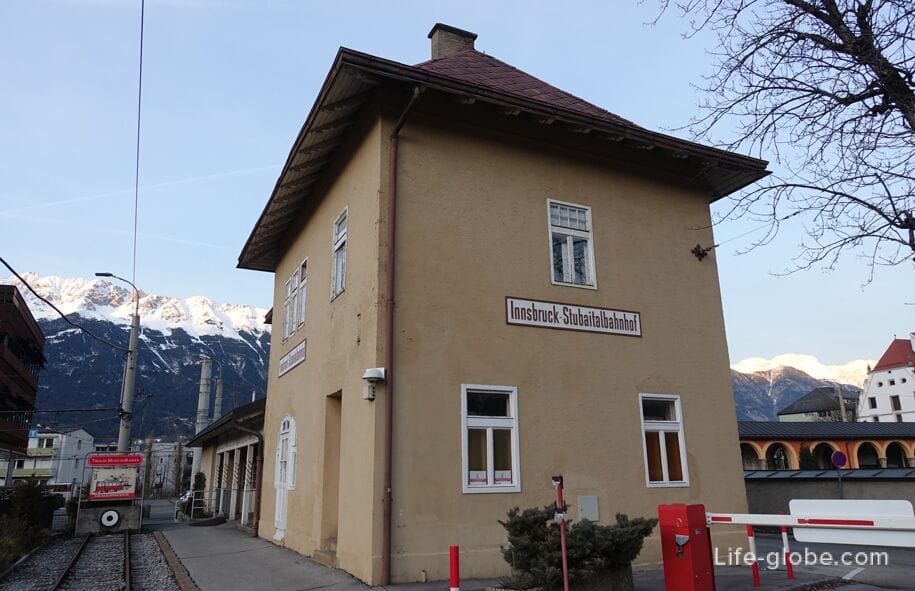
- Anatomical Museum of the Medical University Innsbruck (Anatomisches Museum / Medizinische Universität Innsbruck) which displays parts of the body such as skeletons, bones, skulls, lungs, hearts, etc. aimed at understanding the work in the field of anatomy.
Museum site: anatomisches-museum-innsbruck.
Address: Müllerstraße, 59.
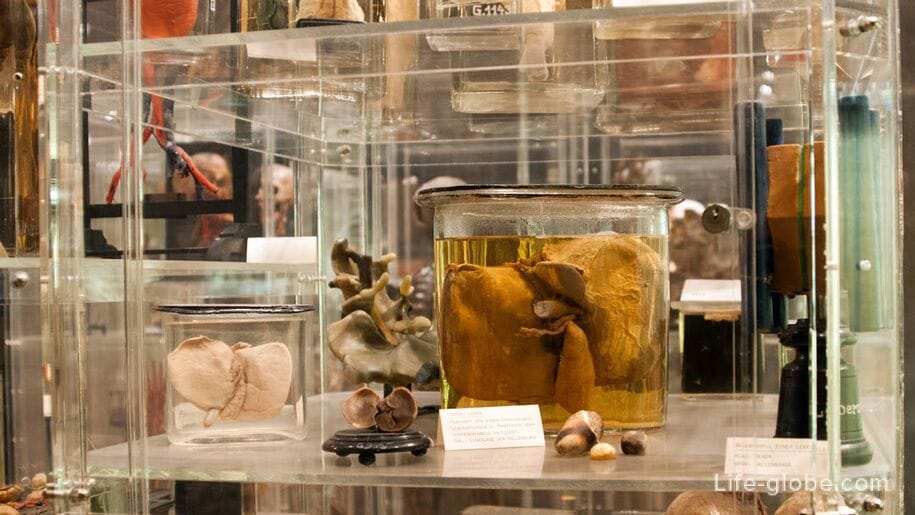
Christmas markets
In anticipation of Christmas and New Year's Eve, Christmas markets Innsbruck are operating in Innsbruck, becoming one of the busiest places in the city.
There are tents at fairs, from which they sell food, including local street food, drinks, the main place among which is warming mulled wine, Christmas products, fried chestnuts, as well as souvenirs, products of local craftsmen, festive paraphernalia, etc.
There are six main Christmas markets in Innsbruck, however, there are two less well-known fairs within the city. More on Christmas markets in Innsbruck…
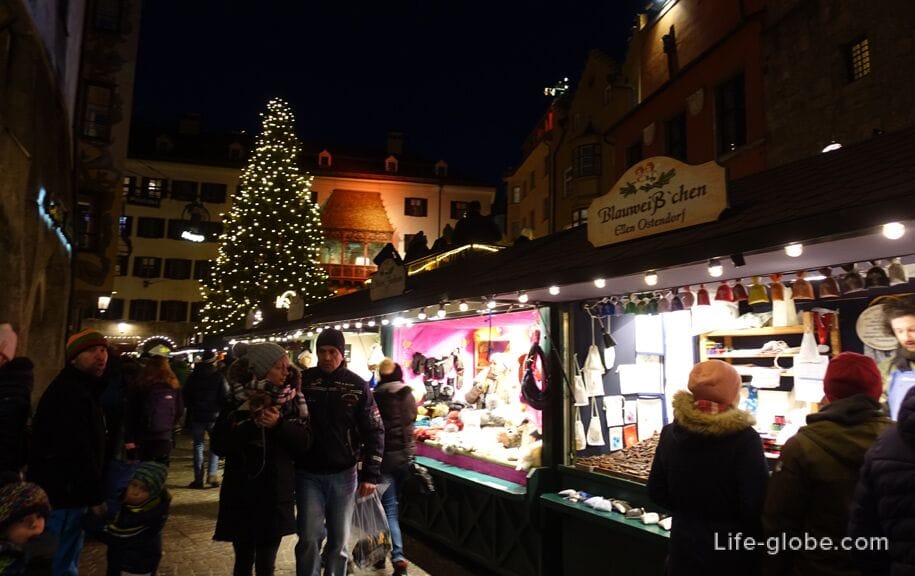
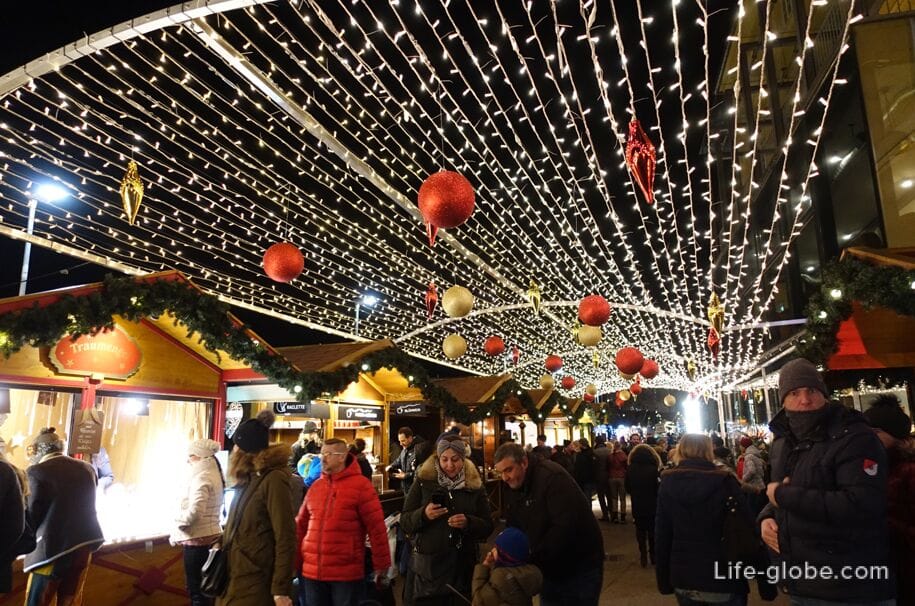
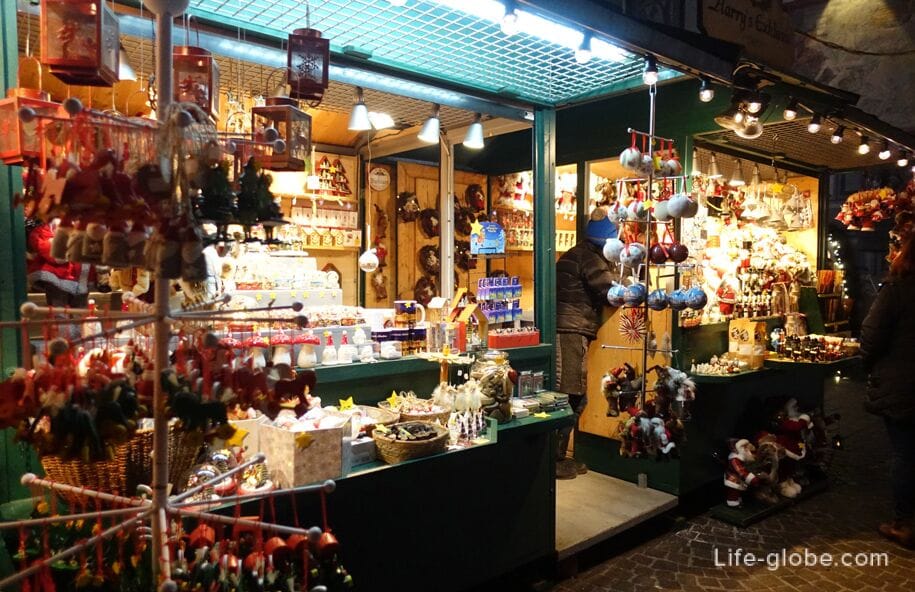
Igls-Patscherkofel
At the southern end of Innsbruck, in the village of Igls, located at the foot of the Patscherkofels, there is a funicular that takes visitors to a mountain hill with hiking trails, a ski area and observation points.
Lift site: patscherkofelbahn.
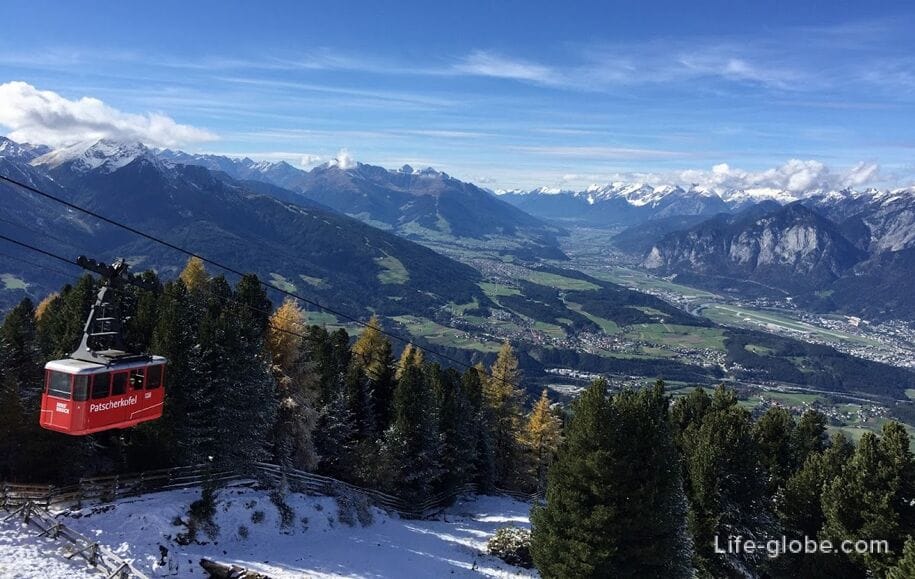
Swarovski Museum Crystal Worlds
The Swarovski Crystal Worlds Museum (Swarovski Kristallwelten) was opened in 1995 in honor of the 100th anniversary of Swarovski and was created by multimedia artist Andre Heller.
The labyrinths and surreal halls of the museum feature crystal installations in an interactive space.
The museum itself is underground, above the surface there is only an entrance made in the form of a large head with eyes made of crystals and covered with greenery. From the mouth of the giant's head, a waterfall erupts, flowing into the pool.
In the open area there is a park with a labyrinth and art objects.
The museum has a Swarovski shop and a cafe-restaurant serving international and seasonal cuisine.
Museum site: kristallwelten.swarovski.
Museum Address: the museum is located not in Innsbruck itself, but in the Wattens commune, which is 19 kilometers from the historical center of Innsbruck, at: Kristallweltenstrasse, 1.

All accommodation facilities in Innsbruck you can view and book here




